RULES AND REGULATIONS
Title 25—ENVIRONMENTAL PROTECTION
ENVIRONMENTAL QUALITY BOARD
[ 25 PA. CODE CH. 250 ]
Administration of the Land Recycling Program
[46 Pa.B. 5655]
[Saturday, August 27, 2016]The Environmental Quality Board (Board) amends Chapter 250 (relating to administration of Land Recycling Program) to read as set forth in Annex A. These amendments satisfy the obligation of the Department of Environmental Protection (Department), as specified in § 250.11 (relating to periodic review of MSCs), to review new scientific information that relates to the basis of medium-specific concentrations (MSC) as it becomes available and to propose appropriate changes for consideration by the Board no more than 36 months after the effective date of the most recently promulgated MSCs.
This final-form rulemaking was adopted by the Board at its meeting on April 19, 2016.
A. Effective Date
This final-form rulemaking will go into effect upon publication in the Pennsylvania Bulletin.
B. Contact Persons
For further information, contact Troy Conrad, Program Manager, Land Recycling Program, P.O. Box 8471, Rachel Carson State Office Building, Harrisburg, PA 17105-8471, (717) 783-7816; or Keith Salador, Assistant Counsel, Bureau of Regulatory Counsel, P.O. Box 8464, Rachel Carson State Office Building, Harrisburg, PA 17105-8464, (717) 783-8075. Persons with a disability may use the Pennsylvania AT&T Relay Service at (800) 654-5984 (TDD users) or (800) 654-5988 (voice users). This final-form rulemaking is available electronically through the Department's web site at http://www.dep.state.pa.us.
C. Statutory Authority
This final-form rulemaking is being made under the authority of sections 104(a) and 303(a) of the Land Recycling and Environmental Remediation Standards Act (act) (35 P.S. §§ 6026.104(a) and 6026.303(a)) and section 1920-A of The Administrative Code of 1929 (71 P.S. § 510-20). Section 104(a) of the act authorizes the Board to adopt Statewide health standards as well as appropriate mathematically valid statistical tests to define compliance with the act and other regulations that may be needed to implement the act. Section 303(a) of the act authorizes the Board to promulgate Statewide health standards for regulated substances for each environmental medium and to promulgate methods used to calculate the standards. Section 1920-A of The Administrative Code of 1929 authorizes the Board to formulate, adopt and promulgate rules and regulations that are necessary for the proper work of the Department.
D. Background and Purpose
Section 250.11 requires the Department to review new scientific information that is used to calculate MSCs under the Statewide health standard and to propose appropriate changes to the Board at least every 36 months. The changes serve the public as they are based on the most up-to-date health and other scientific information to protect human health and welfare. In addition, the changes serve the public and regulated community as they provide clear information on what is required to clean up contaminated sites. This final-form rulemaking was reviewed by the Cleanup Standards Scientific Advisory Board (CSSAB). This final-form rulemaking was discussed and approved at the CSSAB meeting held on December 17, 2014. The CSSAB supported all aspects of the rulemaking except that they raised questions regarding the retention of the groundwater MSC for Methyl Tertiary Butyl Ether (MTBE). As discussed further in Section G of this preamble, the CSSAB asserted that the MTBE groundwater MSC was based on aesthetic considerations under a United States Environmental Protection Agency (EPA) published drinking water advisory rather than specific health-based criteria as required under the act and the regulations thereunder. This final-form rulemaking was reviewed by the Storage Tank Advisory Committee (STAC) on March 3, 2015. The STAC supported all aspects of this final-form rulemaking except for the groundwater MSC for MTBE, reiterating the same questions as the CSSAB.
E. Summary of Regulatory Requirements
§ 250.5. Public notice by applicant
Amendments to this section add the requirement that documented proof of the mailing of municipal notices and the arranging for publication of newspaper notices that are required under the act shall be submitted at the same time the Notice of Intent to Remediate (NIR), plan or report is submitted to the Department. This will allow the Department to assure that the municipality and the public are notified of the NIR, plan or report in a timely fashion.
§ 250.7. Fees
Amendments to this section clarify that the Department may waive the fee for resubmission of a plan or report if the resubmission is related to correcting minor administrative or technical deficiencies.
§ 250.301. Scope
Amendments to this section add certain regulated substances to the list of substances classified as mutagens based on recently published scientific information.
§250.304. MSCs for groundwater
Prior to the January 2011 edition of the Drinking Water Standards and Health Advisories, EPA Office of Water Publication No. EPA 820-R-11-002 (January, 2011), when the EPA published a lifetime Health Advisory Level (HAL) and a 10-4 Cancer Risk concentration for a chemical, the lifetime HAL concentration would include an adjustment for cancer risk. Starting with the January 2011 edition of the Drinking Water Standards and Health Advisories, the EPA changed its Cancer Classification system and started publishing lifetime HALs that did not include adjustments for cancer risk even when a 10-4 Cancer Risk concentration was also published.
Amendments to subsection (c) clarifies that a published lifetime HAL concentration would not be used as the MSC for substances that are designated as likely to be carcinogenic if the lifetime HAL does not include an adjustment for cancer risk. For these cases the MSC will be calculated based on the equations in §§ 250.306 and 250.307 (relating to ingestion numeric values; and inhalation numeric values).
Amendments to subsection (g) include additional references related to the determination of solubility values.
§ 250.306. Ingestion numeric values
Due to new information about the toxicology of trichloroethylene (TCE), values for oral cancer slope factors for TCE were added and the formula for calculating the MSC for TCE was amended.
Due to new information published by the EPA in Exposure Factors Handbook 2011 Edition, EPA/600/R-090/052F, the average body weight and the associated ingestion factors were amended.
§ 250.307. Inhalation numeric values
Due to new information relating to the toxicology of TCE, values for inhalation unit risk for TCE and the formula for calculating the MSC for TCE were amended.
Appendix A, Tables 1—6
Amendments to the Medium-Specific Concentrations tables in Appendix A were made for certain regulated substances. Information was updated on the Physical and Toxicological Properties tables and the Threshold of Regulation Compounds table.
F. Summary of Changes to the Proposed Rulemaking
§ 250.5. Public notice by applicant
The proposed amendments to this section stated that specific documented proof of the mailing of municipal notices and arranging for the publication of newspaper notices is required at the same time the NIR is submitted to the Department. This would have required remediators to wait for public notice documents in advance of submitting reports and NIRs to the Department. The act requires these notices to be made at the same time the NIR or report is submitted to the Department. See section 303(h) of the act and sections 302(e), 304(n) and 305(c) of the act (35 P.S. §§ 6026.302(e), 6026.304(n) and 6026.305(c)). In this final-form rulemaking, this section was revised to allow remediators to provide reasonable proof of publication by submitting the proposed text of the newspaper notice and the anticipated publication date at the same time that the NIR is submitted. This will allow the Department to assure that the municipality and the public are notified of the NIR, plan or report in a timely fashion, in accordance with the act.
§ 250.304. MSCs for groundwater
Section 250.304(g) provides references for sources of solubility limits used in calculating the groundwater MSCs. Paragraph (18) with the reference to Riddick, J.A., et al. was added in this final-form rulemaking to the list of sources.
§ 250.307. Inhalation numeric values
An amendment to an equation in this section corrects a typographical error that occurred between approval and publication of the final-form rulemaking published at 41 Pa.B. 230 (January 8, 2011).
Appendix A, Tables 1—6
Updates to toxicity values published after the proposed rulemaking caused existing MSCs for certain regulated substances to change. In addition, triethylene glycol was added based on new data the EPA published in the Provisional Peer-Reviewed Toxicity Values (PPRTV).
G. Summary of Comments and Responses on the Proposed Rulemaking
Notice of proposed rulemaking was published at 44 Pa.B. 2980 (May 17, 2014). The comment period opened on May 17, 2014, and closed on June 17, 2014. The Board received comments from two commentators in addition to comments from the Independent Regulatory Review Commission (IRRC).
A commentator noted that the residential soil MSC for vanadium is proposed to be decreased by 100 times from 1,500 mg/kg to 15 mg/kg. Furthermore, the commentator asserted that vanadium background concentrations in this Commonwealth range from a minimum of 15 mg/kg to a maximum of 150 mg/kg with an average of 80 mg/kg (Dragun, J. and Chekiri, K. (2005). Element in North America Soils. Amherst, MA: Amherst Scientific Publishers; and Boerngen, J.G and Shacklette, H.T. (1981). ''Chemical Analysis of Soils and Other Surficial Materials of the Conterminous United States.'' Open File Report 81-197. United States Geological Survey). Therefore, the commentator felt it would be more practical to set the MSC at the maximum background concentration of 150 mg/kg. A similar argument was made by the commentator regarding arsenic, which has background concentrations ranges from 3.8 mg/kg to 31 mg/kg. IRRC requested an explanation of the scientific data relied upon for lowering the MSCs for vanadium and arsenic and to explain how the new standards are necessary to protect the public health.
The Department did not propose alteration of the current MSCs for arsenic. The PPRTV oral reference dose (RfDo) of 0.00007 mg/kg-day published by the EPA (Provisional Peer-Reviewed Toxicity Values for Vanadium and Its Soluble Inorganic Compounds Other than Vanadium Pentoxide, EPA, 2009) is the basis for the change in the vanadium MSCs. The prior MSCs for vanadium were based on a RfDo published by the EPA in the Health Effects Assessment Summary Tables (HEAST). This PPRTV RfDo is based on a peer-reviewed toxicity analysis that undergoes greater rigor than the RfDo published in HEAST. The Board and the CSSAB assign greater weight to a PPRTV RfDo than a HEAST RfDo consistent with § 250.605(a) (relating to sources of toxicity information). Therefore, this new value is the appropriate human health level for vanadium under the act.
The act and the regulations promulgated thereunder require the calculation of Statewide health standard MSCs based on human health toxicity values only and not on background soil levels. However, the act does recognize that human health toxicity values for any naturally occurring regulated substance may result in standards that are numerically less than the background levels at specific sites in this Commonwealth. In this case, section 303(d) of the act states that persons are not required to remediate below the background standard. Therefore, persons may use the background standard under the act and the regulations promulgated thereunder.
A commentator also noted that neither the CSSAB nor the STAC support the existing groundwater and soil-to-groundwater MSCs for MTBE which the Department did not propose to amend in this rulemaking. The commentator concurred with the CSSAB and the STAC assessment that the MTBE standard does not use specific health-based standards. The commentator also supported the recommendations submitted by the two Department advisory committees and recommended that the proposed rulemaking be revised to reflect an altered MTBE standard. IRRC requested that the advisory committees' concerns regarding the MSCs for MTBE be addressed in the preamble and the Regulatory Analysis Form of the final-form rulemaking. IRRC also requested an explanation of how the MTBE MSCs meet the criteria established in the act and how the MTBE MSCs adequately protect public health, safety and welfare.
The Department did not propose alteration of the current MTBE groundwater MSC in this final-form rulemaking. Therefore, comments regarding the groundwater MSC are outside the scope of this final-form rulemaking. The MTBE groundwater MSC appears in this final-form rulemaking only because the entire table of standards has been reproduced and set forth in its entirety for clarity. Section 301(c) of the act (35 P.S. § 6026.301(c)) requires Federally or State promulgated groundwater maximum contaminant level (MCL) and HALs to be the groundwater MSC. Currently six regulated substances have groundwater MSCs that are Federally promulgated MCLs which are solely based on secondary effects (aesthetic thresholds, for example, taste and odor). Since the act requires the use of MCLs and HALs when available, the act therefore allows for groundwater MSCs to be based on drinking water standards that are not health-based, but are aesthetic-based to protect public health and welfare. The EPA may include taste and odor considerations as well as health-based calculations in its promulgation of MCLs. See section 1401(2) of the Federal Safe Drinking Water Act (42 U.S.C.A. § 300f(2)).
In Chapter 250 as initially adopted at 27 Pa.B. 4181 (August 16, 1997), the Board promulgated a groundwater MSC for MTBE of 20 µg/L based on a draft lifetime HAL published by the EPA at the time. In subsequent publications of the Federal drinking water standards, the EPA listed MTBE under a separate table, titled Drinking Water Advisories, with an advisory level of 20 µg/L. The EPA concluded that despite limited health-based information, the drinking water advisory is consistent with human health protection goals. The Department suggests that decision was a sound decision to prevent water from having an odor after a cleanup is completed and to protect the public health and welfare. The Board decided not to propose a change in the MSC for MTBE because the drinking water advisory level does not reflect a change in the degree of protectiveness from the original draft HAL. The EPA continues to indicate that it is further evaluating MTBE for an MCL determination. The Department will continue to monitor EPA's progress and communications related to this MCL determination.
H. Benefits, Costs and Compliance
Benefits
The Department updates the Statewide health standard MSC values on a regular basis to assure that environmental response actions at contaminated sites are remediated using current EPA guidance and toxicological information. This will ensure the protection of public health and the environment from exposure to regulated substances when it has been determined that lower concentrations of regulated substances are required to meet the standards established by the act. This will also avoid unnecessary expense for remediators when remediating contaminated property for redevelopment when it has been determined that higher concentrations of regulated substances are protective and meet the standards established by the act.
Compliance costs
These technical amendments to Chapter 250 will affect owners, operators and purchasers of properties and facilities who volunteer or are required to perform remediation of releases and of contaminated sites. These technical amendments are not expected to add any significant costs to the cleanup of releases or contaminated sites under the Land Recycling Program. Some cleanup standard concentration values will be lower and some will be higher. The net overall cost should be negligible.
Compliance assistance plan
The Land Recycling Program will disseminate information concerning these updates using the Department's web site and e-mail to environmental consultants involved in the Land Recycling Program.
Paperwork requirements
No forms or reports are required beyond those established by the act.
I. Pollution Prevention
The Pollution Prevention Act of 1990 (42 U.S.C.A. §§ 13101—13109) established a National policy that promotes pollution prevention as the preferred means for achieving state environmental protection goals. The Department encourages pollution prevention, which is the reduction or elimination of pollution at its source, through the substitution of environmentally friendly materials, more efficient use of raw materials and the incorporation of energy efficiency strategies. Pollution prevention practices can provide greater environmental protection with greater efficiency because they can result in significant cost savings to facilities that permanently achieve or move beyond compliance requirements.
During remediation of a contaminated site, potential sources of pollution are often removed to attain the standards in the act, thus eliminating or minimizing the potential for continued migration.
J. Sunset Review
Chapter 250 will be reviewed in accordance with the sunset review schedule published by the Department to determine whether the regulations effectively fulfills the goals for which they were intended.
K. Regulatory Review
Under section 5(a) of the Regulatory Review Act (71 P.S. § 745.5(a)), on April 28, 2014, the Department submitted a copy of the notice of proposed rulemaking, published at 44 Pa.B. 2980, to IRRC and the Chairpersons of the House and Senate Environmental Resources and Energy Committees for review and comment.
Under section 5(c) of the Regulatory Review Act, the Department shall submit to IRRC and the House and Senate Committees copies of comments received during the public comment period, as well as other documents when requested. In preparing the final-form rulemaking, the Department has considered all comments from IRRC and the public.
Under section 5.1(j.2) of the Regulatory Review Act (71 P.S. § 745.5a(j.2)), on June 29, 2016, the final-form rulemaking was deemed approved by the House and Senate Committees. Under section 5.1(e) of the Regulatory Review Act, IRRC met on June 30, 2016, and approved the final-form rulemaking.
L. Findings
The Board finds that:
(1) Public notice of the proposed rulemaking was given under sections 201 and 202 of the act of July 31, 1968 (P.L. 769, No. 240) (45 P.S. §§ 1201 and 1202) and regulations promulgated thereunder, 1 Pa. Code §§ 7.1 and 7.2.
(2) A public comment period was provided as required by law, and all comments were considered.
(3) These regulations do not enlarge the purpose of the proposed rulemaking published at 44 Pa.B. 2980.
(4) These regulations are necessary and appropriate for the administration and enforcement of the acts identified in Section C of this preamble.
M. Order
The Board, acting under the authorizing statutes, orders that:
(a) The regulations of the Department, 25 Pa. Code Chapter 250, are amended by amending §§ 250.5, 250.7, 250.301, 250.304, 250.306 and 250.307 and Appendix A, Tables 1—6, with ellipses referring to the existing text of the regulations.
(b) The Chairperson of the Board shall submit this order and Annex A to the Office of General Counsel and the Office of Attorney General for review and approval as to legality and form, as required by law.
(c) The Chairperson of the Board shall submit this order and Annex A to IRRC and the Senate and House Environmental Resources and Energy Committees as required under the Regulatory Review Act (71 P.S. §§ 745.1—745.14).
(d) The Chairperson of the Board shall certify this order and Annex A and deposit them with the Legislative Reference Bureau, as required by law.
(e) This order shall take effect immediately.
PATRICK McDONNELL,
Acting Chairperson(Editor's Note: See 46 Pa.B. 3894 (July 16, 2016) for IRRC's approval order.)
Fiscal Note: Fiscal Note 7-486 remains valid for the final adoption of the subject regulations.
Annex A
TITLE 25. ENVIRONMENTAL PROTECTION
PART I. DEPARTMENT OF ENVIRONMENTAL PROTECTION
Subpart D. ENVIRONMENTAL HEALTH AND SAFETY
ARTICLE VI. GENERAL HEALTH AND SAFETY
CHAPTER 250. ADMINISTRATION OF LAND RECYCLING PROGRAM
Subchapter A. GENERAL PROVISIONS § 250.5. Public notice by applicant.
(a) Public notice under the background, Statewide health or site-specific standard and under a special industrial area cleanup shall be initiated by the applicant through an NIR. For remediations proposing the use of a site-specific standard or, for remediations under an SIA agreement, the public and the municipality where the site is located shall be provided a 30-day period, in the NIR, in which the municipality may request to be involved in the development of the remediation and reuse plans for the site.
(b) The remedial investigation report, the risk assessment report and the cleanup plan, prepared under a site-specific remediation, may not be submitted to the Department until after the initial 30-day public and municipal comment period following the submission of the NIR has expired.
(c) The baseline environmental report, prepared under an SIA remediation, shall be submitted after the initial 30-day public and municipal comment period has expired.
(d) For areas not covered entirely by a nonuse aquifer areawide certification granted under § 250.303(f) (relating to aquifer determination; current use and currently planned use of aquifer groundwater), at the same time a request for a nonuse aquifer designation under the Statewide health standard is made to the Department, the remediator shall send notice to every municipality and community water supplier servicing the area requested for designation as nonuse under § 250.303(b). The notice must include a copy of the request for determination of nonuse aquifer submitted to the Department.
(e) Upon receipt of notice of a request for a nonuse aquifer designation, the municipality and community water supplier shall have 45 days to indicate to the Department and the remediator any information relevant to the requirements of § 250.303.
(f) Reasonable proof of the mailing of the municipal notices and arranging for the publication of newspaper notices, required under sections 302(e), 303(h), 304(n) and 305(c) of the act (35 P.S. §§ 6026.302(e), 6026.303(h), 6026.304(n) and 6026.305(c)), shall be submitted at the same time the NIR, plan or report is submitted to the Department. Examples of reasonable proof include:
(1) A copy of the letter to the municipality with a United States Postal Service Certified Mail Receipt, PS Form No. 3800.
(2) A copy of the proposed text of the newspaper notice and the anticipated publication date.
§ 250.7. Fees.
(a) Resubmission of a cleanup plan, remedial investigation, risk assessment or final report will require payment of the appropriate fee identified in the act for each resubmission.
(b) The Department will disapprove a plan or report that is submitted without the appropriate fee.
(c) The Department may waive the fee for resubmission of a plan or report if the resubmission is related to correcting minor administrative or technical deficiencies. The fee waiver is limited to the following:
(1) One time for each plan or report to correct administrative deficiencies if the corrections are made within 15 days of notice of the deficiencies by the Department.
(2) One time for each plan or report to correct technical deficiencies if the corrections are made within 60 days of notice of the deficiencies by the Department.
Subchapter C. STATEWIDE HEALTH STANDARDS § 250.301. Scope.
(a) This subchapter sets forth generic Statewide health standards as one of three remediation standards that a person may select. The Statewide health standards are concentrations of regulated substances associated with a specific environmental medium, and are designated as the MSCs. The values used to determine the MSCs are contained in Appendix A, Tables 1—4 and 6 and are the concentrations of regulated substances that shall be met to demonstrate attainment of a Statewide health standard. Appendix A, Table 5 presents the toxicological and physical parameters used to calculate the MSCs in Appendix A, Tables 1—4.
(b) This subchapter sets forth generic Statewide health standards for regulated substances determined by the EPA to be mutagens. Appendix A, Tables 1—4 contain Statewide health standards based upon the methodology for mutagens in §§ 250.306 and 250.307 (relating to ingestion numeric values; and inhalation numeric values) for the following substances classified as mutagens:
Regulated Substance CAS Number Acrylamide 79-06-1 Benzo[a]anthracene 56-55-3 Benzidine 92-87-5 Benzo[a]pyrene 50-32-8 Benzo[b]fluoranthene 205-99-2 Benzo[k]fluoranthene 207-08-9 Chromium (VI) 18540-29-9 Chrysene 218-01-9 Dibenzo[a,h]anthracene 53-70-3 Dibromo-3-chloropropane, 1,2- 96-12-8 Dichloromethane 75-09-2 Indeno[1,2,3-cd]pyrene 193-39-5 Methylene bis(2-chloroaniline), 4,4`- 101-14-4 Nitrosodiethylamine, N- 55-18-5 Nitrosodimethylamine, N- 62-75-9 Nitroso-N-ethylurea, N- 759-73-9 Trichloroethylene (TCE) 79-01-6 Trichloropropane, 1,2,3- 96-18-4 Vinyl chloride 75-01-4 (c) This subchapter sets forth minimum threshold MSCs for soil and groundwater that shall be met to demonstrate attainment of the Statewide health standards for regulated substances in Appendix A, Table 6. Minimum threshold MSCs are standards developed for regulated substances for which no chemical-specific toxicological data exist.
(d) For regulated substances which do not have an MSC for the relevant medium on Appendix A, Tables 1—4 or 6, the background standard or site-specific standard shall be met to qualify for a release of liability under the act.
§ 250.304. MSCs for groundwater.
(a) A person shall implement a remedy under the Statewide health standard that is protective of human health and the environment.
(b) The MSCs for regulated substances in groundwater are presented in Appendix A, Tables 1 and 2. The methodology used by the Department for calculating MSCs in groundwater is detailed in subsections (c)—(f).
(c) The MSCs for regulated substances contained in groundwater in aquifers used or currently planned to be used for drinking water or for agricultural purposes are the MCLs as established by the Department or the EPA in § 109.202 (relating to State MCLs, MRDLs and treatment technique requirements). For regulated substances where no MCL has been established, the MSCs are the Lifetime Health Advisory Levels (HAL) set forth in Drinking Water Standards and Health Advisories (DWSHA), EPA Office of Water Publication No. EPA 822-S-12-001 (April 2012 or as revised), except for substances designated in the DWSHA with cancer descriptor (L) ''Likely to be carcinogenic to humans'' or (L/N) ''Likely to be carcinogenic above a specific dose but not likely to be carcinogenic below that dose because a key event in tumor formation does not occur below that dose.'' New or revised MCLs or HALs promulgated by the Department or the EPA shall become effective immediately for any demonstration of attainment completed after the date the new or revised MCLs or HALs become effective.
(1) For regulated substances where neither an MCL nor a lifetime HAL has been established and for substances designated in the DWSHA with cancer descriptor (L) or (L/N), the MSCs are the lowest concentration calculated using the appropriate residential and nonresidential exposure assumptions and the equations in §§ 250.306 and 250.307 (relating to ingestion numeric values; and inhalation numeric values).
(2) If the Lifetime HAL for a substance designated in the DWSHA with cancer descriptor (L) or (L/N) is less than the MSC calculated under paragraph (1), then the Lifetime HAL shall be the MSC.
(d) For regulated substances contained in aquifers not used or currently planned to be used, the MSCs in Appendix A, Tables 1 and 2 are calculated by the following:
(1) For volatile organic regulated substances with an attenuation factor of less than 20, as calculated by the methodology in paragraph (7), ten times the appropriate residential or nonresidential MSC for groundwater in aquifers used or currently planned to be used containing less than 2,500 mg/l total dissolved solids.
(2) For volatile organic regulated substances with an attenuation factor of greater than or equal to 20, as calculated by the methodology in paragraph (7), 100 times the appropriate residential or nonresidential MSC for groundwater in aquifers used or currently planned to be used containing less than 2,500 mg/l total dissolved solids.
(3) For semivolatile organic and inorganic regulated substances, regardless of the attenuation factor, 1,000 times the appropriate residential or nonresidential MSC for groundwater in aquifers used or currently planned to be used containing less than 2,500 mg/l total dissolved solids.
(4) For benzene, 100 times the appropriate residential or nonresidential MSC for groundwater in aquifers used or currently planned to be used containing less than 2,500 mg/l total dissolved solids.
(5) For regulated substances with no calculated attenuation factor because of a lack of data in Howard, P. H., R. S. Boethling, W. F. Jarais, W. M. Meylan and E. M. Michalenko. 1991. Handbook of Environmental Degradation Rates. Lewis Publishers, Inc., Chelsea, MI, the appropriate residential or nonresidential MSC for groundwater in aquifers used or currently planned to be used containing less than 2,500 mg/l total dissolved solids.
(6) For minimum threshold MSCs, 5 micrograms per liter in groundwater shall be used.
(7) The attenuation factor (AF) for an organic regulated substance shall be calculated according to the following formula:
AF = K × KOC
Where:
K = degradation coefficient = 0.693
T1/2T1/2—half-life of organic regulated substance in groundwater as reported in Howard, P. H., R. S. Boethling, W. F. Jarais, W. M. Meylan and E. M. Michalenko, 1991. Handbook of Environmental Degradation Rates. Lewis Publishers, Inc., Chelsea, MI.
KOC—organic carbon partitioning coefficient (see Appendix A, Table 5).
(e) If the groundwater in aquifers used or currently planned for use at the site has naturally occurring background total dissolved solids concentrations greater than 2,500 milligrams per liter, the Statewide health standard for a regulated substance dissolved in the groundwater may be adjusted by multiplying the MSC for groundwater in aquifers by 100. The adjusted Statewide health standard shall then be used in calculating the soil to groundwater pathway numeric value as specified in § 250.308 (relating to soil to groundwater pathway numeric values).
(f) In addition to the requirements in this section, the MSCs are further limited by solubility as identified in Appendix A, Table 5. The solubility limits are derived from the references in subsection (g), which are keyed to the numbers in Appendix A, Table 5. The following procedure was used to determine the appropriate solubility value for each regulated substance: where multiple sources are cited in Appendix A, Table 5, the value for the solubility limit is the median of the values in the indicated references.
(1) Using the hierarchy established in subsection (g), the first two references were consulted. If the solubility values agreed within 5%, the selected value is the lower of the two values.
(2) If the values in step (1) did not agree within 5%, the next references in order were consulted until two values that did agree within 5% were found. The selected value is then the median of all the values consulted.
(3) If none of the values in all of the references in subsection (g) agreed within 5%, the selected value is the median of all values in all references.
(g) The references referred to in subsection (f) are:
(1) Lide, D. R., ed. 1996. CRC Handbook of Chemistry and Physics, 77th Edition. CRC Press.
(2) Budavari, S., ed. 1996. The Merck Index, 12th Ed. Merck and Co.
(3) Perry, R. H., et al. 1997. Perry's Chemical Engineer's Handbook, 7th ed. McGraw-Hill, New York.
(4) Howard, P. H. 1991. Handbook of Environmental Fate and Exposure Data for Organic Chemicals. Vol. III Pesticides, Lewis Publishers.
(5) Verschueren, K. 1977, Handbook of Environmental Data on Organic Chemicals, Van Nostrand Reinhold.
(6) MacKay, D., et al. 1997, Illustrated Handbook of Physical-Chemical Properties and Environmental Fate for Organic Chemicals, 5 Volumes. Lewis Publishers, New York.
(7) Montgomery, J. H. 1991, Groundwater Chemicals Desk Reference, Vol. II. Lewis Publishers and Montgomery, J. H., and L. M. Welkom. 1990, Groundwater Chemicals Desk Reference Vol I, Louis Publishers.
(8) Milne, G.W.A., ed. 1995, CRC Handbook of Pesticides, CRC Press, Inc.
(9) National Library of Medicine (Grateful Med), Hazardous Substances Databank.
(10) EPA.1994, Superfund Chemical Data Matrix. Office of Solid Waste and Emergency Response, EPA 540-R-94-009.
(11) Mabey, et al. 1982, Aquatic Fate Process Data for Organic Priority Pollutants, SRI. EPA Contract Nos. 68-01-3867, 68-03-2981.
(12) Yalkowsky, S.H. and R.M. Dannenfelser. 1992. Aquasol Database of Aqueous Solubility. Version 5. College of Pharmacy, University of Arizona—Tucson, AZ. PC Version.
(13) Estimate from Log Kow.
(14) Bennett, S.R., J.M. Bane, P.J. Benford, and R.L. Pyatt. 1984. Environmental Hazards of Chemical Agent Simulants. CRDC-TR-84055, Aberdeen Proving Ground, Md.
(15) Munro, N.B. et al. 1999. The Sources, Fate, and Toxicity of Chemical Warfare Agent Degradation Products. Environ. Health Perspect. 107(12): 933-4.
(16) Monteil-Rivera, F., C. Groom, and J. Hawari. 2003. Sorption and Degradation of Octahydro-1,3,5,7-Tetranitro-1,3,5,7-Tetrazocine in Soil. Environ. Sci. Technol. 37:3878—3884.
(17) Seidell, A.1941. Solubilities of Organic Compounds. New York, NY. D. Van Nostrand Co. Inc.
(18) Riddick, J. A., et al. 1986. Organic Solvents; Physical Properties & Methods of Purification. Techniques of Chemistry. 11th Edition. New York, NY: Wiley-Interscience.
§ 250.306. Ingestion numeric values.
(a) For a regulated substance which is a systemic toxicant, the ingestion numeric value for that substance was calculated using the appropriate residential or nonresidential exposure assumptions from subsection (d) according to the following equation:
MSC = THQ × RfDo × BW × ATnc × 365 days/year
_________________
Abs × EF × ED × IngR × CF(b) For a regulated substance which is a carcinogen, the ingestion numeric value for that substance was calculated using the appropriate residential or nonresidential exposure assumptions from subsection (d) according to the following equations:
(1) For regulated substances not identified as a mutagen in § 250.301(b) (relating to scope):
MSC = TR × ATc × 365 days/year
_________________
CSFo × Abs × EF × IFadj × CF(2) For regulated substances identified as a mutagen, except for vinyl chloride and trichloroethylene, in § 250.301(b):
MSC = TR × ATc × 365 days/year
_________________
CSFo × Abs × EF × AIFadj × CF(3) For vinyl chloride:
MSC = TR
_____________________________________
[CSFo × Abs × EF × IFadj × CF / (ATc × 365 days/year)] + (CSFo × Abs × IRc × CF/BWc)(4) For trichloroethylene:
MSC = TR × ATc × 365 days/yr
___________________________
(CSFok × AIFadj + CSFol × IFadj) × Abs × EF × CF(c) For a regulated substance that has both an oral reference dose and an oral cancer slope factor, the ingestion numeric value is the lower of the two numbers as calculated by the equations in subsections (a) and (b).
(d) The default exposure assumptions used to calculate the ingestion numeric values are as follows:
Residential
Nonresidential Term Systemic1 Carcinogens2,6 (Onsite Worker) THQ Target Hazard Quotient 1 N/A 1 RfDo Oral Reference Dose (mg/kg-day) Chemical-specific N/A Chemical-specific BW Body Weight (kg) N/A Soil 15 80 Groundwater 80 80 ATnc Averaging Time for systemic toxicants (yr) Soil 6 N/A 25 Groundwater 30 N/A 25 Abs Absorption (unitless)3 1 1 1 EF Exposure Frequency (d/yr) Soil 250 250 180 Groundwater 350 350 250 ED Exposure Duration (yr) Soil 6 N/A 25 Groundwater 30 N/A 25 IngR Ingestion Rate Soil (mg/day) 100 N/A 50 GW (L/day) 2 N/A 1 CF Conversion Factor Soil (kg/mg) 1 × 10-6 1 × 10-6 1 × 10-6 GW (unitless) 1 1 1 TR Target Risk N/A 1 × 10-5 1 × 10-5 CSFo Oral Cancer Slope Factor (mg/kg-day)-1 N/A Chemical-specific Chemical-specific ATc Averaging Time for carcinogens (yr) N/A 70 70 IFadj4 Ingestion Factor N/A Soil (mg-yr/kg-day) 55 15.6 GW (L-yr/kg day) 1 0.3 AIFadj5 Combined Age-Dependent Adjustment Factor and Ingestion Factor N/A N/A Soil (mg-yr/kg-day) 241 GW (L-yr/kg-day) 3.23 CSFok TCE oral cancer slope factor for kidney cancer (mg/kg/day)-1 9.3 × 10-3 CSFol TCE oral cancer slope factor for non-Hodgkin lymphoma and liver cancer (mg/kg/day)-1 3.7 × 10-2 Notes:
1 Residential exposure to noncarcinogens is based on childhood (ages 1—6) exposure for soil, and adult exposure for groundwater, consistent with USEPA (1991).
2 Residential exposure to carcinogens is based on combined childhood and adult exposure.
3 The oral absorption factor takes into account absorption and bioavailability. In cases where the oral RfD or CSF is based on administered oral dose, the absorption factor would be limited to bioavailability. The default value is 1.
4 The Ingestion Factor for the residential scenario is calculated using the equation Ifadj = EDc × IRc/BWc + EDa × IRa/Bwa, where EDc = 6 yr, IRc = 100 mg/day for soils and 1 L/day for groundwater, BWc = 15 kg, EDa = 24 yr, IRa = 50 mg/day for soils and 2 L/day for groundwater, and BWa = 80 kg. The ingestion factor for the nonresidential scenario is calculated using the equation Ifadj = ED × IR/BW, where ED = 25 yr, IR = 50 mg/day for soils and 1 L/day for groundwater, and BW = 80 kg.
5 The Combined Age-Dependent Adjustment Factor and Ingestion Factor (AIFadj) for the residential scenario is calculated using the equation AIFadj = [(ADAF‹2 × ED‹2) + (ADAF2-6 × ED2-6)] × IRc / BWc + [(ADAF›6-16 × ED›6-16) + (ADAF›16 × ED›6-16)] × IRa / BWa, where ADAF‹2 = 10, ED ‹2 = 2 yr, ADAF2-6 = 3, ED2-6 = 4 yr, IRc = 100mg/day for soils and 1 L/day for groundwater, BWc = 15 kg, ADAF›6-16 = 3, ED›6-16 = 10 yr, ADAF›16 = 1, ED›16 = 14 yr, IRa = 50 mg/day for soils and 2 L/day for groundwater, and BWa = 80 kg.
6 For the equation to calculate the vinyl chloride residential MSC based on the carcinogenic effect, IRc = 100 mg/day for soils and 1 L/day for groundwater, BWc = 15 kg.
(e) The residential ingestion numeric value for lead in soil was developed using the Uptake Biokinetic (UBK) Model for Lead (version 0.4) developed by the EPA (U.S. Environmental Protection Agency. (1990). Uptake Biokinetic (UBK) Model for Lead (version 0.4). U.S. EPA/ECAO. August 1990, in lieu of the algorithms presented in subsections (a) and (b). Default input values are identified in Appendix A, Table 7. Because the UBK model is applicable only to children, the nonresidential ingestion numeric value was calculated according to the method developed by the Society for Environmental Geochemistry and Health (Wixson, B. G. (1991)). The Society for Environmental Geochemistry and Health (SEGH) Task Force Approach to the Assessment of Lead in Soil. Trace Substances in Environmental Health. (11-20), using the following equations:

Table 7 identifies each of the variables in this equation.
§ 250.307. Inhalation numeric values.
(a) For a regulated substance which is a systemic toxicant, the following applies:
(1) For a volatile compound, the numeric value for inhalation from soil shall be calculated using the appropriate residential or nonresidential exposure assumptions from subsection (d) according to the following equation using TF for volatiles:
MSC = THQ × RfCi × ATnc × 365 days/yr × 24 hr/day × TF
___________________________
ET × EF × ED(2) For a regulated substance attached to particulates, the numeric value for inhalation from soil was calculated using the appropriate residential or nonresidential exposure assumptions from subsection (d) according to the equation in paragraph (1) using TF for particulates.
(b) For a regulated substance which is a carcinogen, the following apply:
(1) For a volatile compound, the numeric value for inhalation from soil was calculated using the appropriate residential or nonresidential exposure assumptions from subsection (d) according to the following equation using TF for volatiles:
MSC = TR × ATc × 365 days/year × 24 hr/day × TF
_________________
IUR × ET × EF × ED × CF(2) For a regulated substance attached to particulates, the numeric value for inhalation from soil was calculated using the appropriate residential or nonresidential exposure assumptions from subsection (d) according to the equation in paragraph (1) using TF for particulates.
(3) For a regulated substance identified in § 250.301(b) (relating to scope) as a mutagen, except for vinyl chloride and trichloroethylene, the numeric value for inhalation from soil was calculated using the appropriate residential or nonresidential exposure assumptions from subsection (d) according to the following equation using the TF for volatiles or particulates:
MSC = TR × ATc × 365 days/year × 24 hr/day × TF
_________________
IUR × ET × EF × AED × CF(4) For vinyl chloride, the numeric value for inhalation from soil was calculated using the appropriate residential or nonresidential exposure assumptions from subsection (d) according to the following equation using the TF for volatiles or particulates:
MSC = TR
_____________________________________
[IUR × ET × EF × ED × CF / (ATc × 365 days/yr × 24 hr/d × TF)] + (IUR × CF × TF)
(5) For trichloroethylene, the numeric value for inhalation from soil was calculated using the appropriate residential or nonresidential exposure assumptions from subsection (d) according to the following equation using the TF for volatiles:
MSC = TR × ATc × 365 days/yr × 24 hr/day × TF
_________________
(IURk × AED + IURl × ED) × ET × EF × CF(c) For a regulated substance which is both a systemic toxicant and a carcinogen, the inhalation numeric value is the lower of the two numbers as calculated by the equations in subsections (a) and (b).
(d) The default exposure assumptions used to calculate the inhalation numeric values for soil are as follows:
Residential
Nonresidential Term Systemic1 Carcinogens2 (Onsite Worker) THQ Target Hazard Quotient 1 N/A 1 RfCi Inhal. Reference Concentration (mg/m3) Chemical-specific N/A Chemical-specific ATnc Averaging Time for systemic toxicants (yr) 30 N/A 25 TF Transport Factor (mg/kg)/(mg/m3) Volatilization3 Chemical-specific Chemical-specific Chemical-specific Particulate4 1 × 1010 1 × 1010 1 × 1010 ET Exposure Time (hr/day) 24 24 8 EF Exposure Frequency5 (d/yr) 250 250 180 ED Exposure Duration (yr) 30 30 25 CF Conversion Factor N/A 1000 µg/mg 1000 µg/mg TR Target Risk N/A 1 × 10-5 1 x 10-5 IUR Inhalation Unit Risk (µg/m3)-1 N/A Chemical-specific Chemical-specific ATc Averaging Time for carcinogens (yr) N/A 70 70 AED Combined Age-Dependent Adjustment Factor and Exposure Duration (yr)6 N/A 76 N/A IURk TCE inhalation unit risk for kidney cancer (ug/m3)-1 1 × 10-6 IURl TCE inhalation unit risk for both non-Hodgkin lymphoma and liver cancer (ug/m3)-1 3 × 10-6 Notes: Modified from USEPA Region III Risk-based Concentration Table, dated October 20, 1995.
N/A = Not Applicable
1 Residential exposure to systemic toxicants is based on adult exposure, consistent with USEPA (1991).
2 Residential exposure to carcinogens is based on combined child and adult exposure.
3 Volatilization transport factor is calculated using TF = (ER × DF)-1, where DF = 12 (mg/m3)/(m2-sec). See soil depth-specific algorithm for the calculation of ER.
4 Particulate transfer factor was calculated using TF = (ER × DF)-1, where ER = 8.25 × 10-12 (mg/m2-sec)/(mg/kg) and DF = 12(mg/m3)/(mg/m2-sec).
5 Assumes approximately 100 days/yr with the ground being frozen. Exposure to surficial soils when the ground is frozen is considered de minimis. The nonresidential exposure frequency is defined as 5/7 × 250 days/yr.
6 The Combined Age-Dependent Adjustment Factor and Exposure Duration (AED) is calculated using the equation AED = ADAF‹2 × ED‹2 + ADAF2-16 × ED2-16 + ADAF›16 × ED›16, where ADAF‹2 = 10, ED‹2 = 2 yr, ADAF2-16 = 3, ED2-16 = 14 yr, ADAF›16 = 1, ED›16 = 14 yr.
* * * * * (g) For a regulated substance which is a carcinogen and is a volatile compound, the numeric value for the inhalation of volatiles from groundwater shall be calculated by using the appropriate residential or nonresidential exposure assumptions from subsection (h) according to the following equations:
(1) For regulated substances not identified as a mutagen in § 250.301(b):
MSC = TR × ATc × 365 days/year
_________________
IUR × ET × EF × ED × TF × CF(2) For regulated substances identified as a mutagen, except for vinyl chloride and trichloroethylene, in § 250.301(b):
MSC = TR × ATc × 365 days/year × 24 hr/day
_________________
IUR × ET × EF × AED × TF × CF(3) For vinyl chloride:
MSC = TR
_____________________________________
[(IUR × ET × EF × ED × TF × CF) / (ATc × 365 days/year × 24 hr/day)] + (IUR × TF × CF)(4) For trichloroethylene:
MSC = TR × ATc × 365 days/yr × 24 hr/day
_________________
(IURk × AED + IURl × ED) × ET × EF × TF × CF(h) The default exposure assumptions used to calculate the inhalation numeric values for the inhalation of volatiles from groundwater are as follows:
Residential
Nonresidential Term Systemic1 Carcinogens2 (Onsite Worker) THQ Target Hazard Quotient 1 N/A 1 RfCi Inhal. Reference Concentration (mg/m3) Chemical-specific N/A Chemical-specific ATnc Averaging Time for systemic toxicants (yr) 30 N/A 25 ET Exposure Time (hr/day) 24 24 8 EF Exposure Frequency (d/yr) 350 350 250 ED Exposure Duration (yr) 30 30 25 TF Transfer Factor (L/m3)3 0.5 0.5 0.5 CF Conversion Factor N/A 1,000 µg/mg 1,000 µg/mg TR Target Risk N/A 1 × 10-5 1 × 10-5 IUR Inhalation Unit Risk (ug/m3)-1 N/A Chemical-specific Chemical-specific ATc Averaging Time for carcinogens (yr) N/A 70 70 AED Combined Age-Dependent adjustment Factor and Exposure Duration (yr)4 N/A 76 N/A IURk TCE inhalation unit risk for kidney cancer (ug/m3)-1 1 × 10-6 IURl TCE inhalation unit risk for both non-Hodgkin lymphoma and liver cancer (ug/m3)1 3 × 10-6 Notes: Modified from USEPA Region III Risk-based Concentration Table, dated October 20, 1995.
N/A = Not Applicable
1 Residential exposure to systemic toxicants is based on adult exposure, consistent with USEPA (1991).
2 Residential exposure to carcinogens is based on combined child and adult exposure.
3 Default Transfer Factor is as presented in USEPA's RAGS, Part B.
4 The Combined Age-Dependent Adjustment Factor and Exposure Duration (AED) is calculated using the equation AED = ADAF‹2 × ED‹2 + ADAF2-16 × ED2-16 + ADAF›16 × ED›16 where ADAF‹2 = 10, ED‹2 = 2 yr, ADAF2-16 = 3, ED2-16 = 14 yr, ADAF›16 = 1, ED›16 = 14 yr.
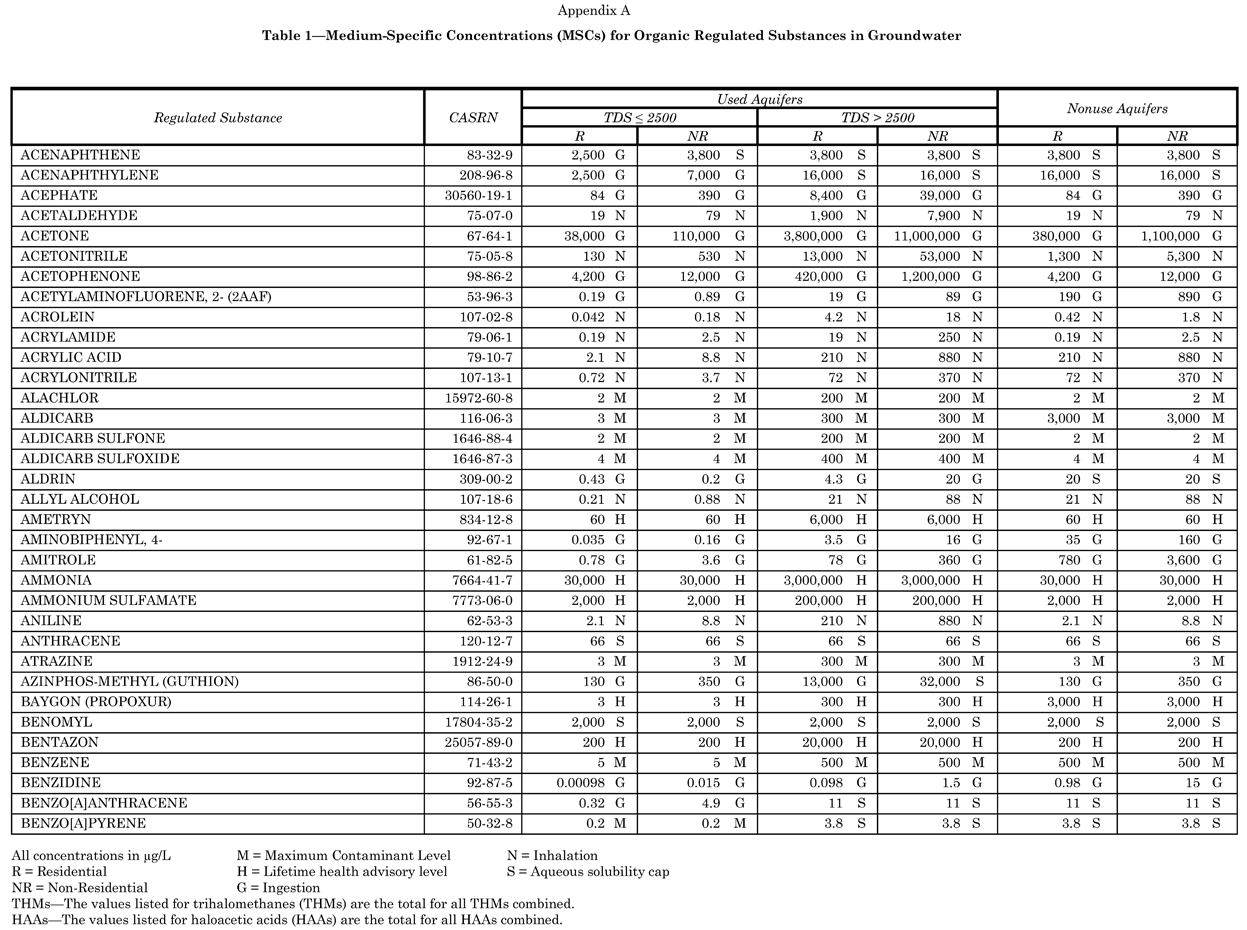
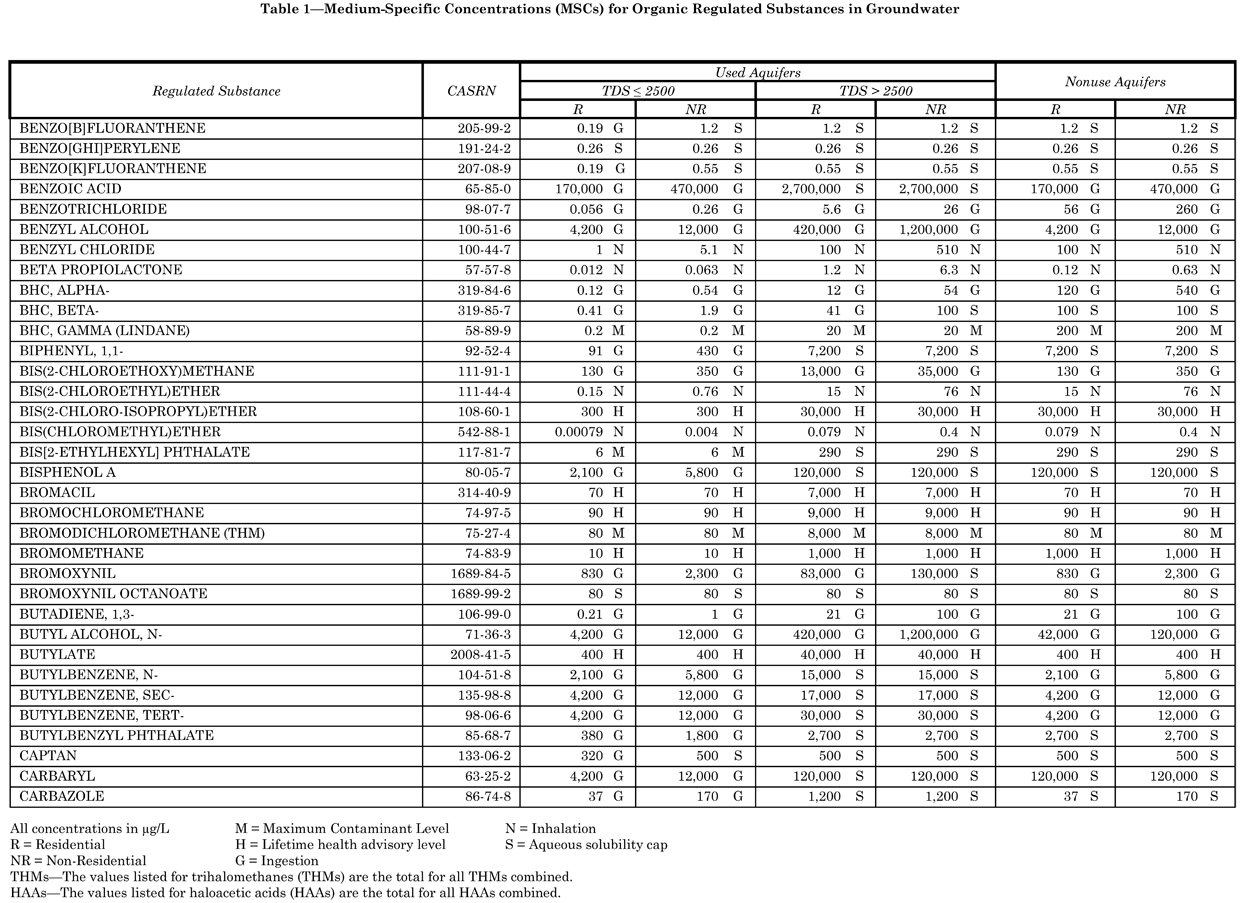
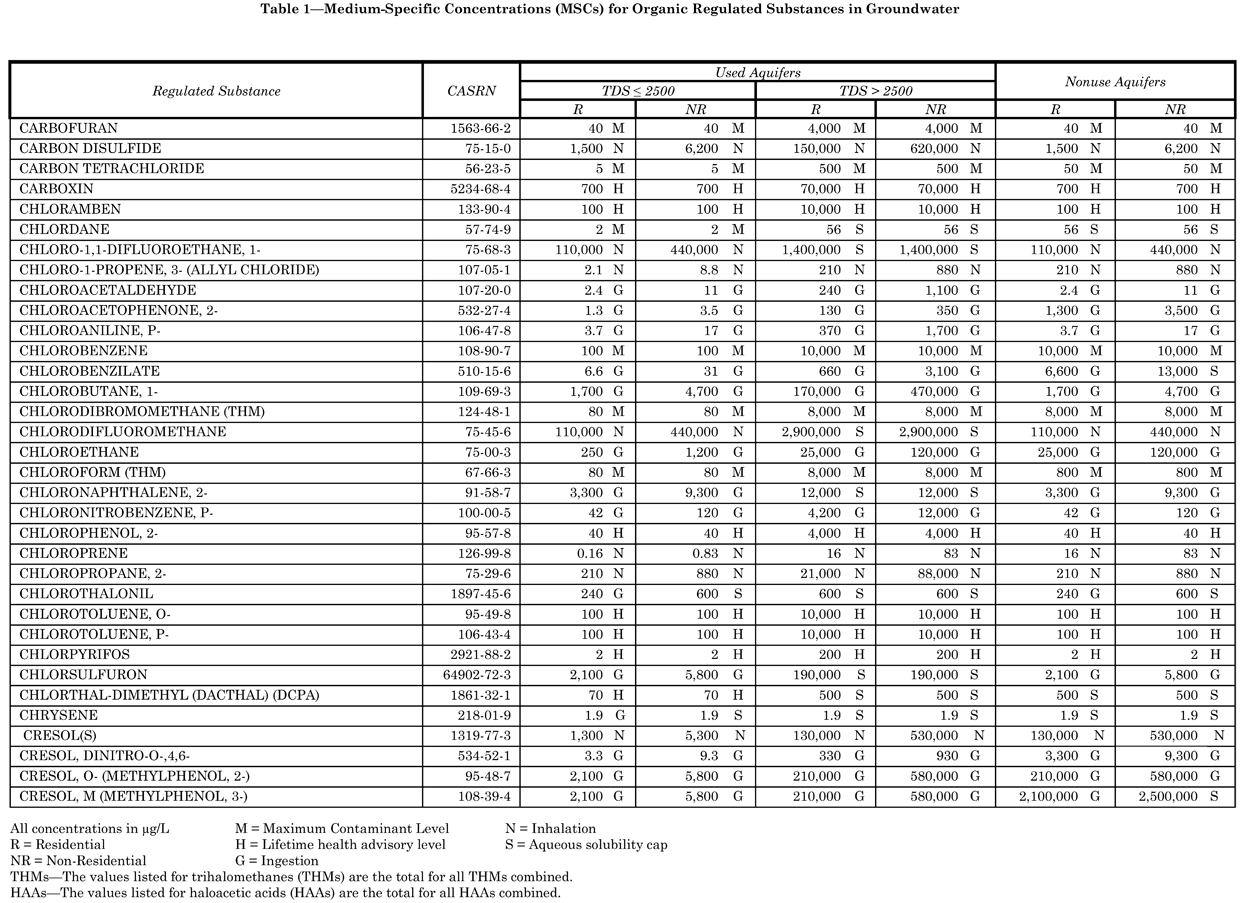
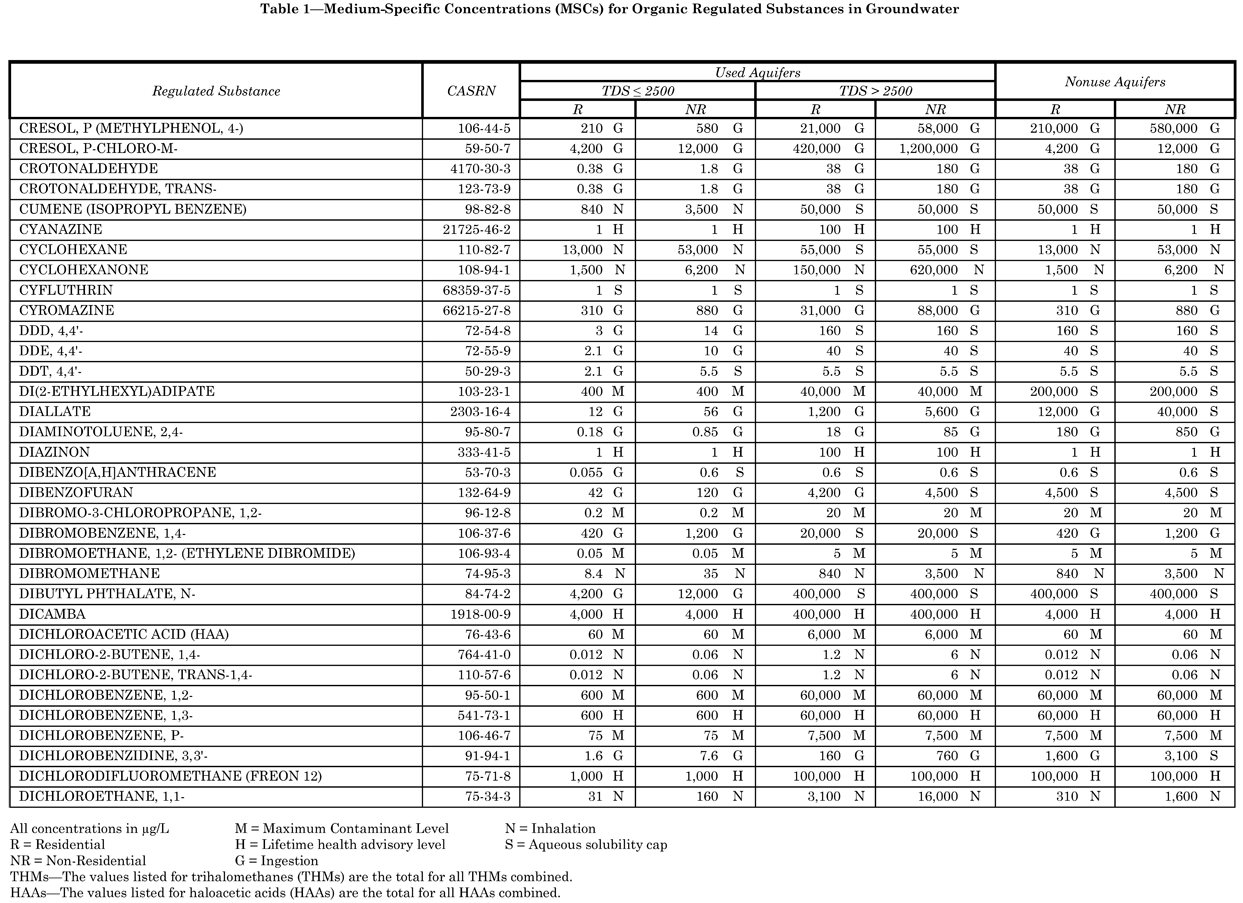
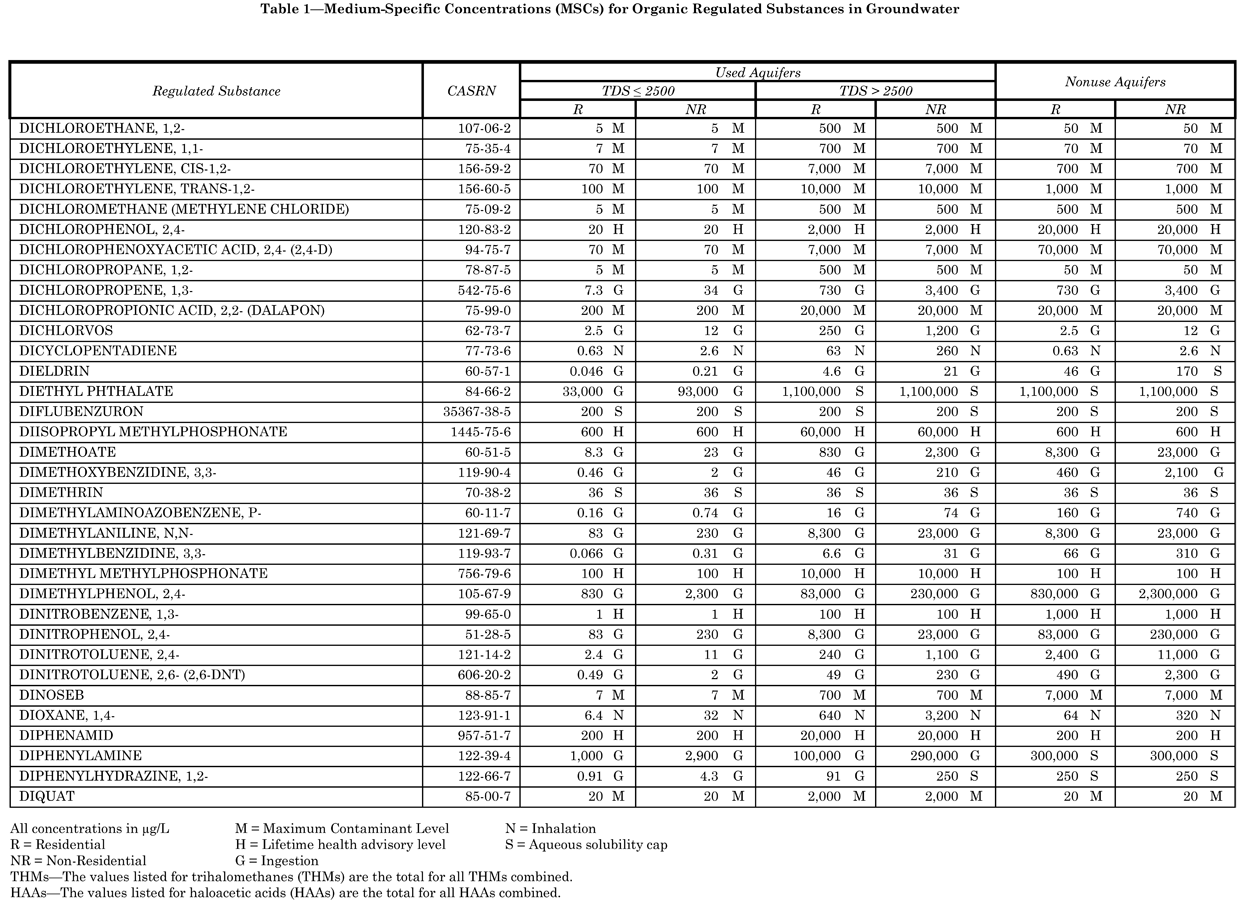
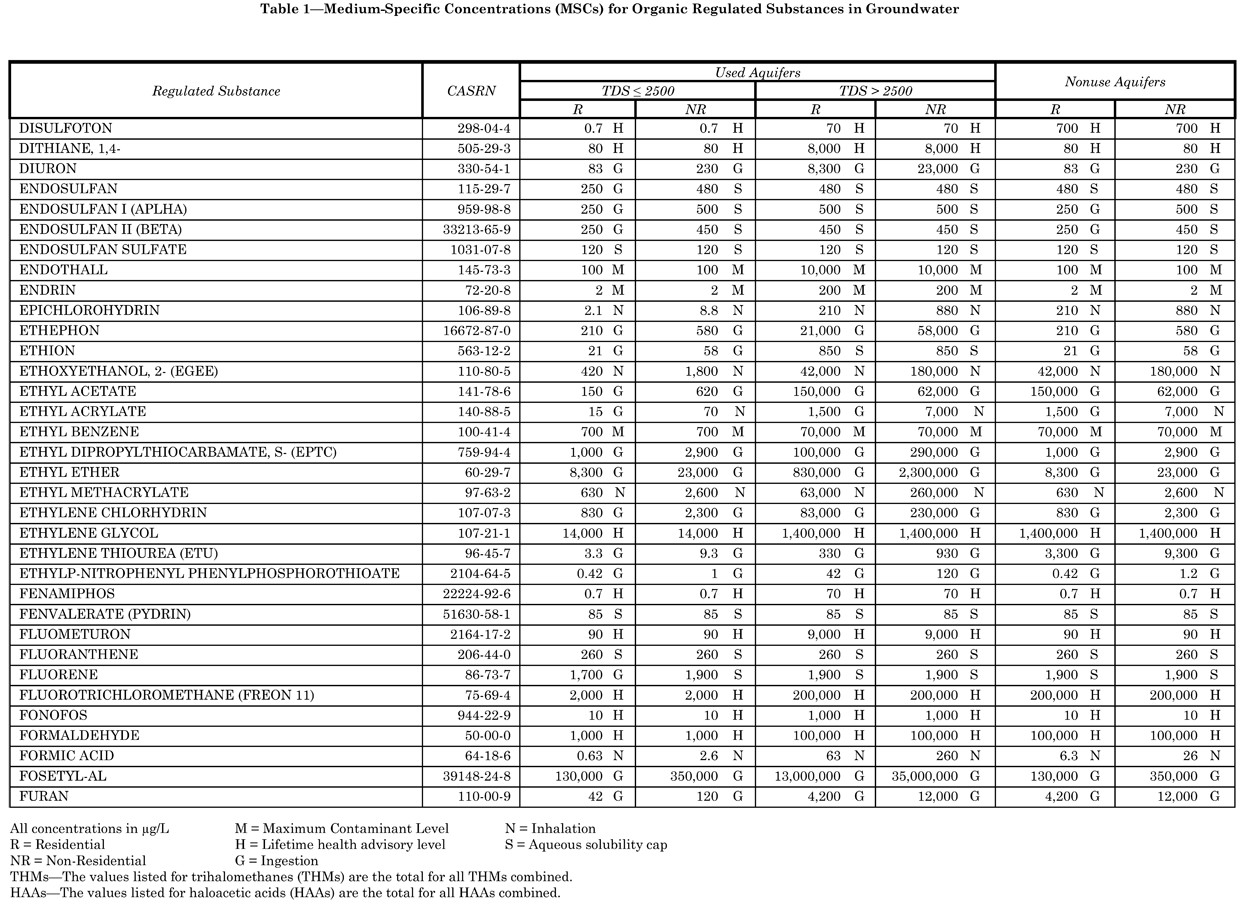
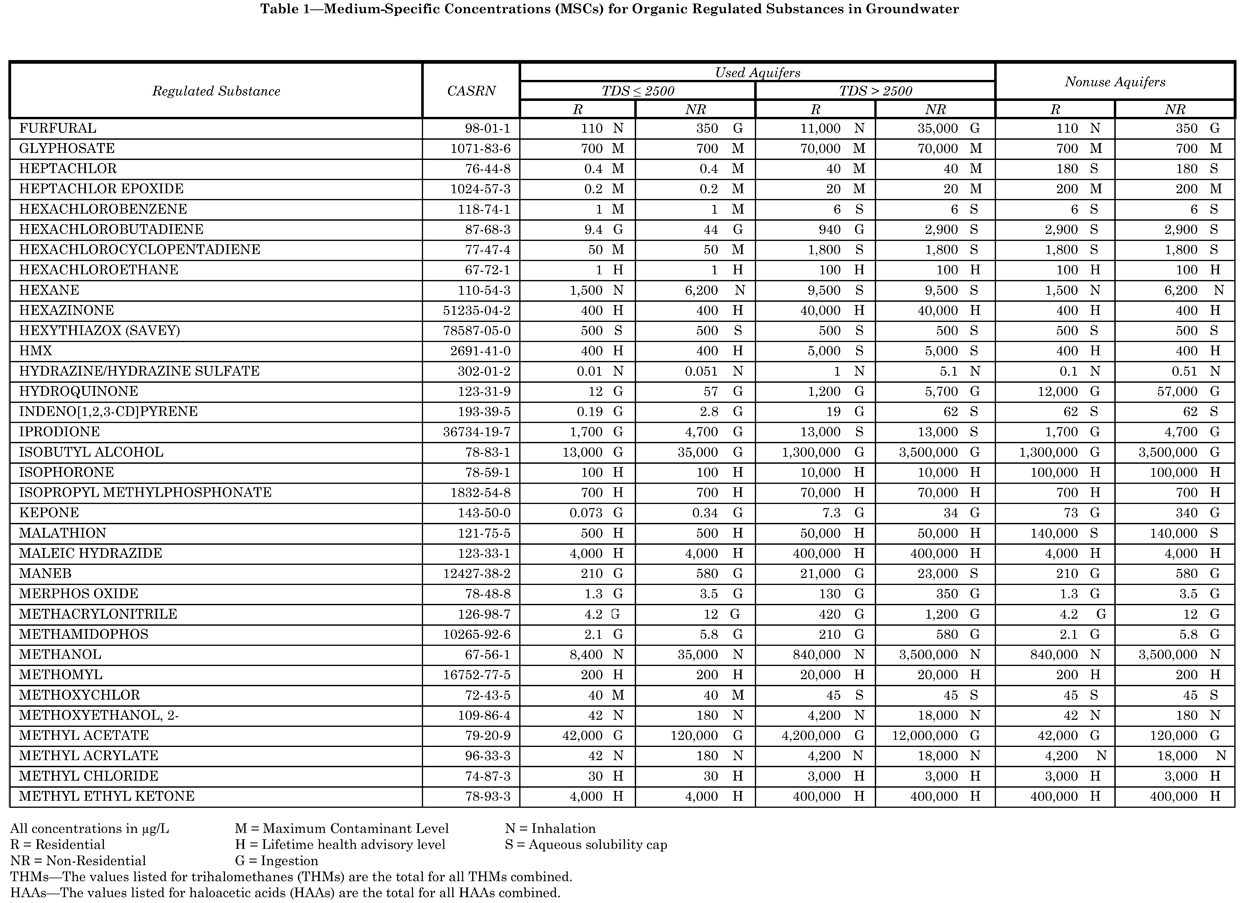
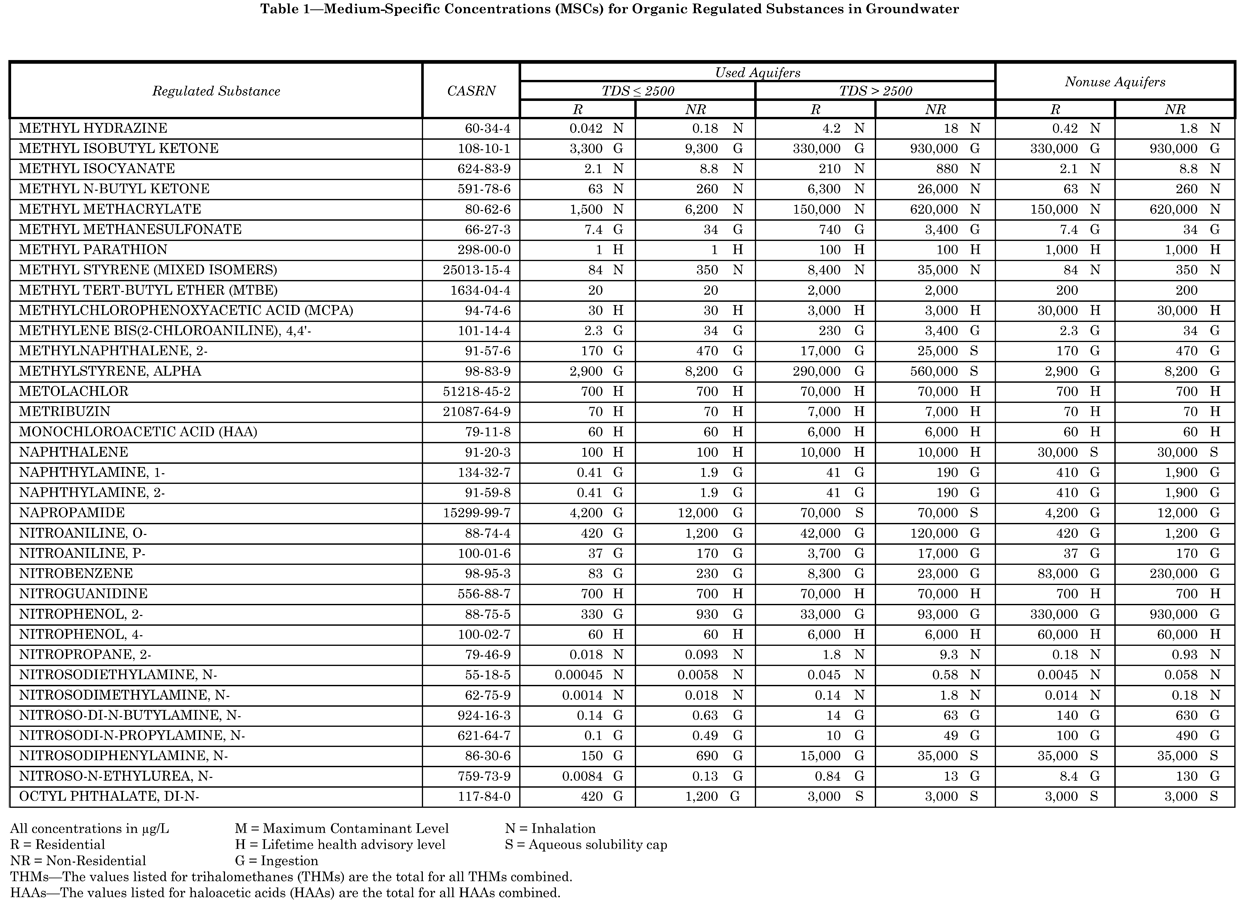
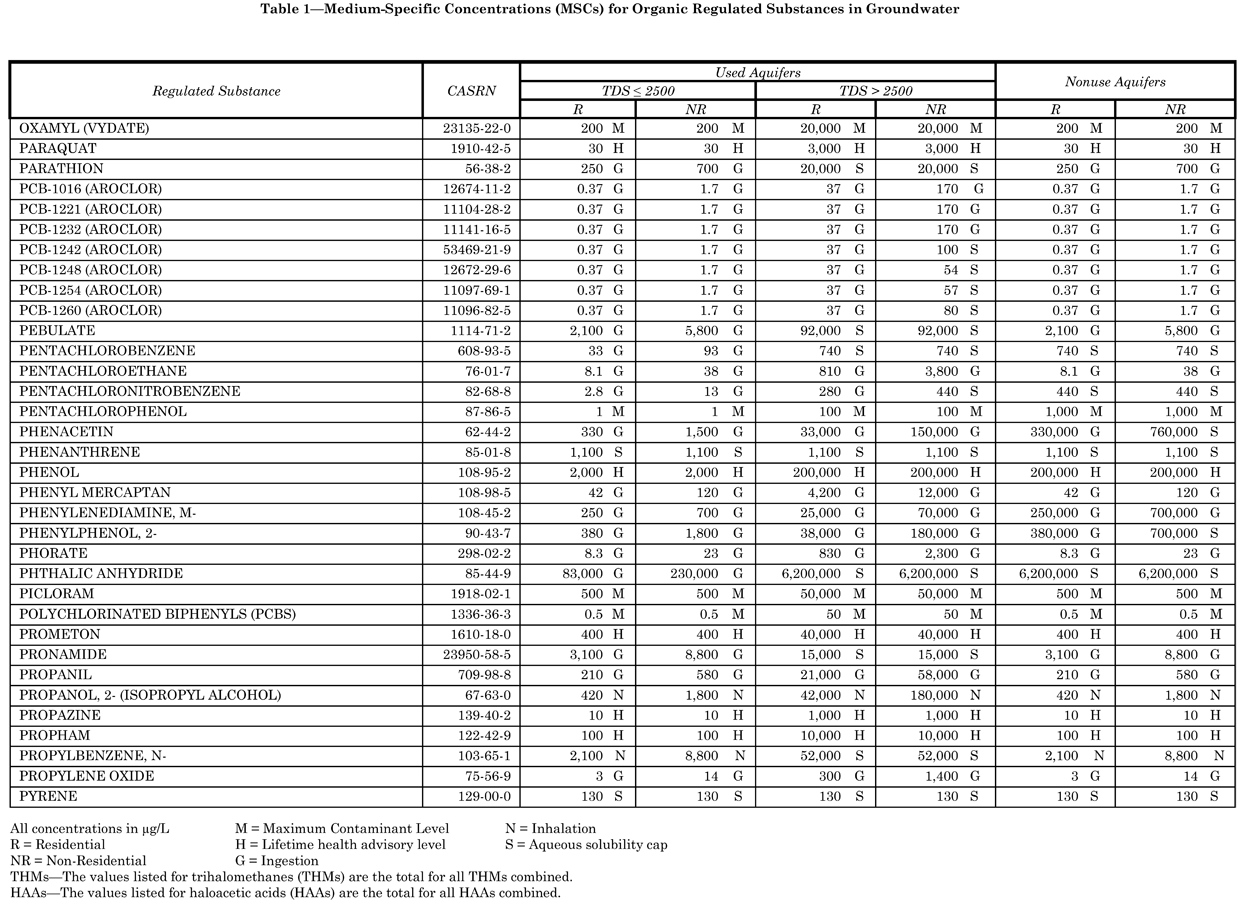
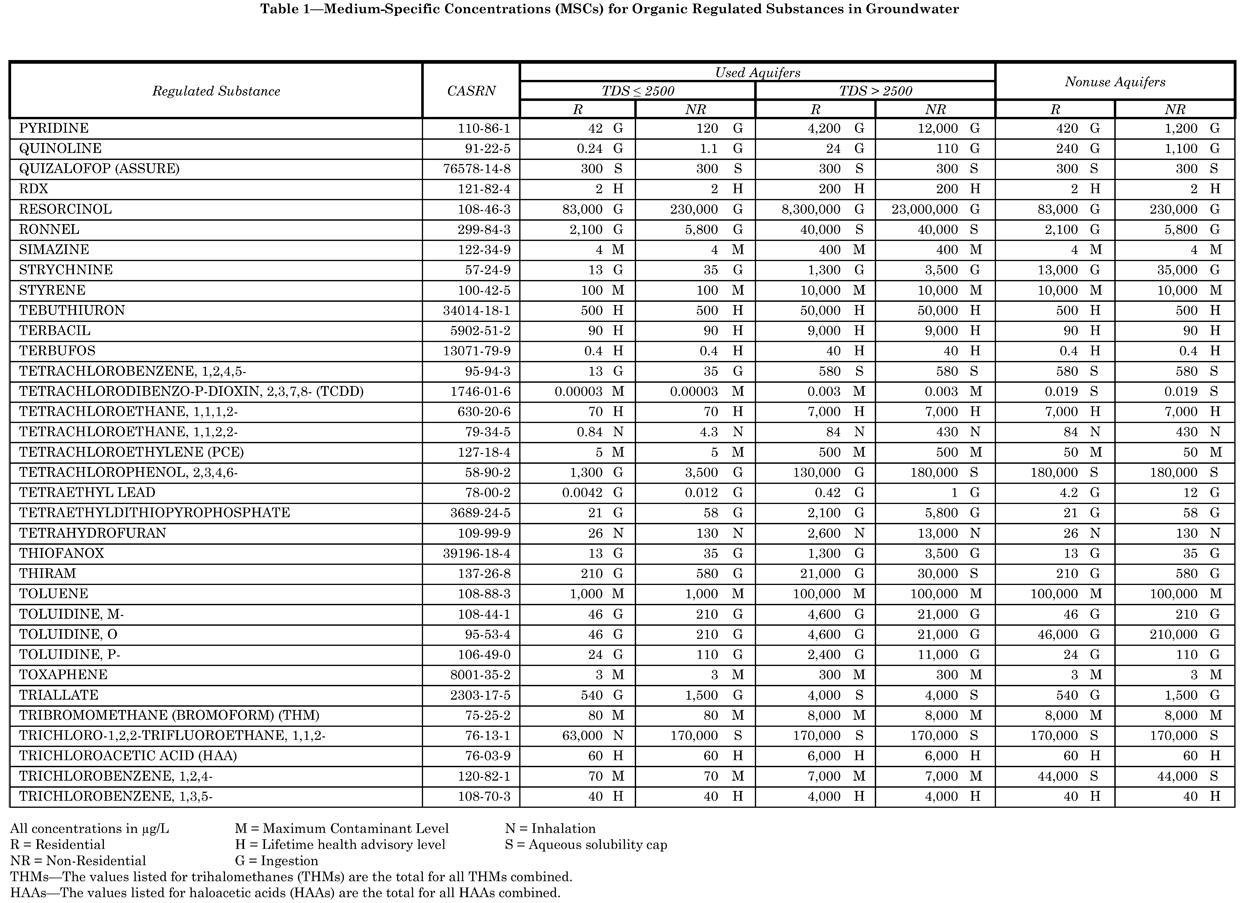
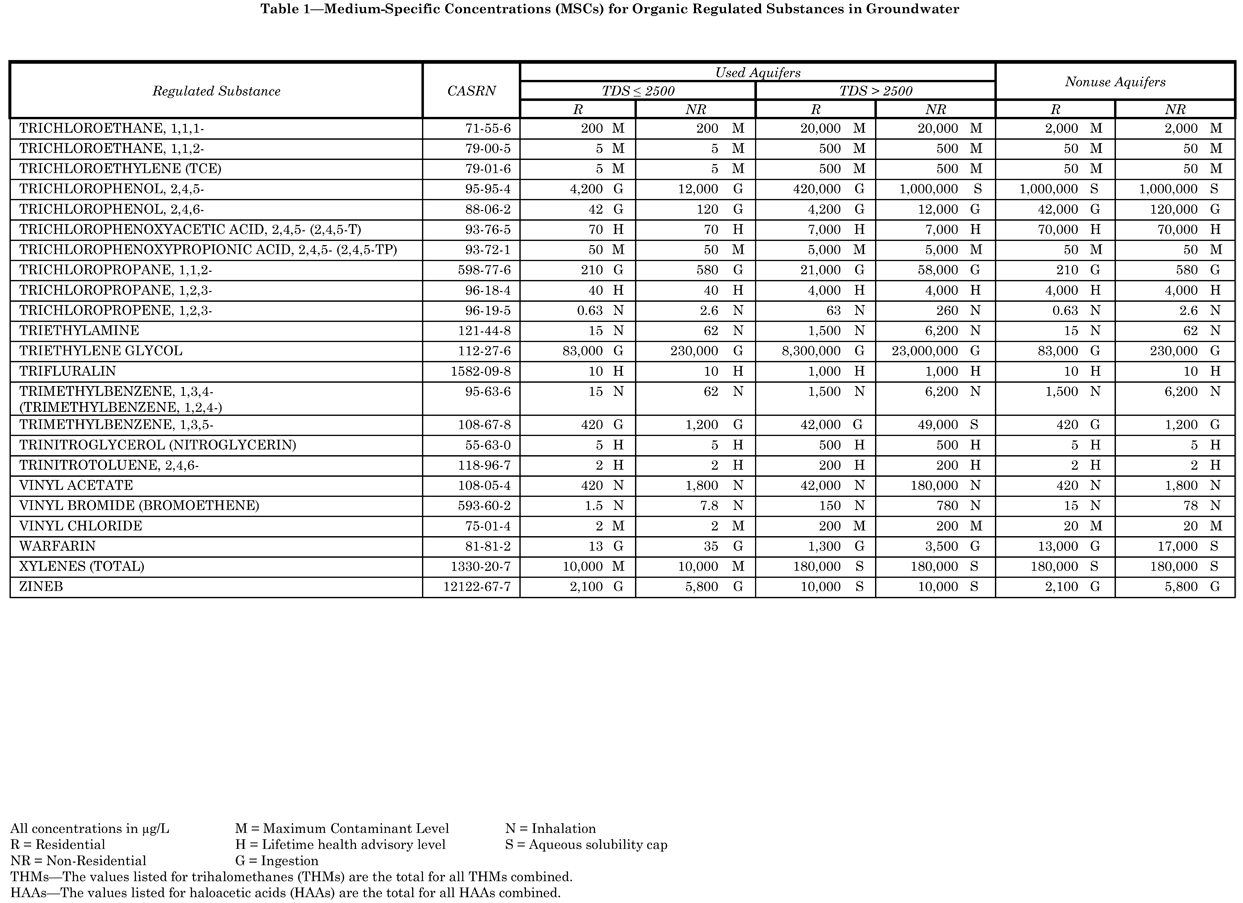
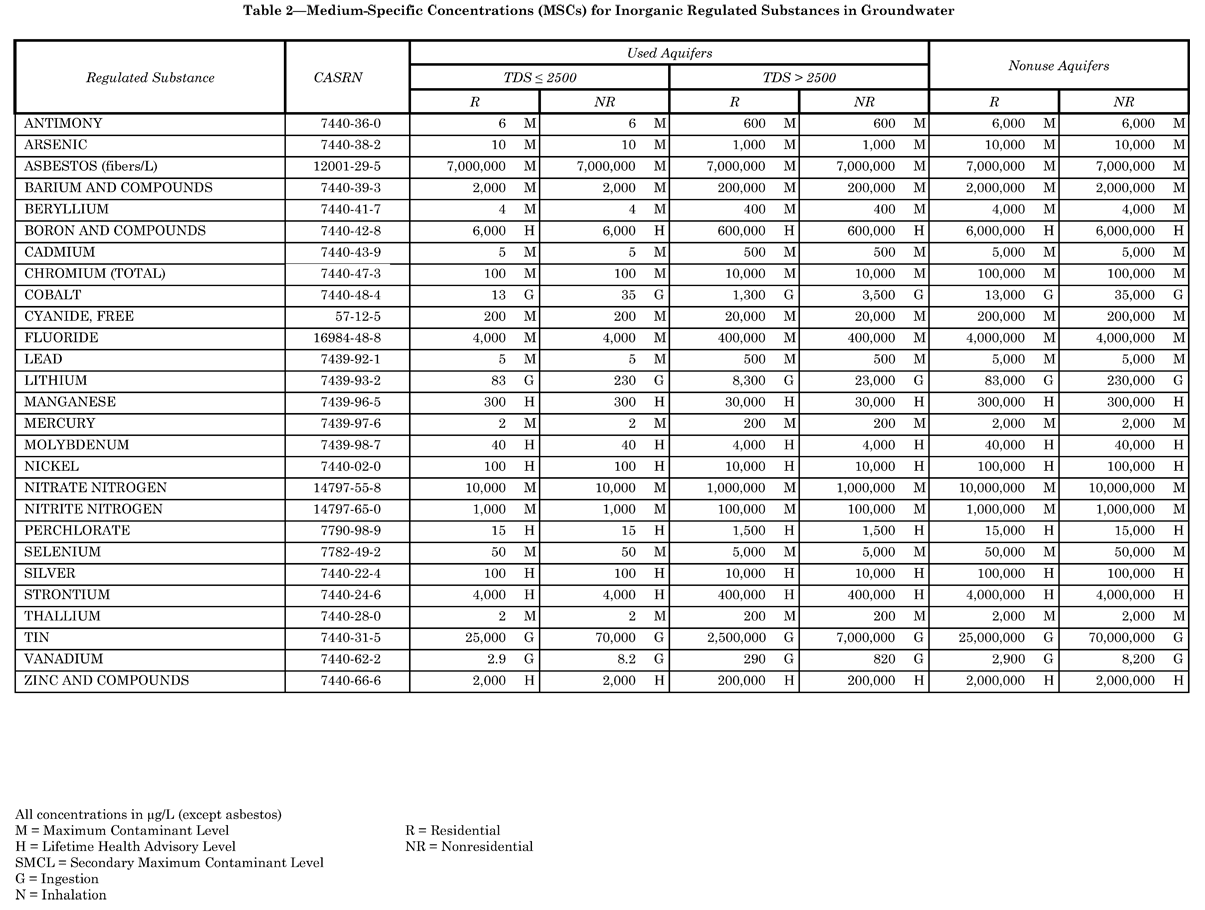
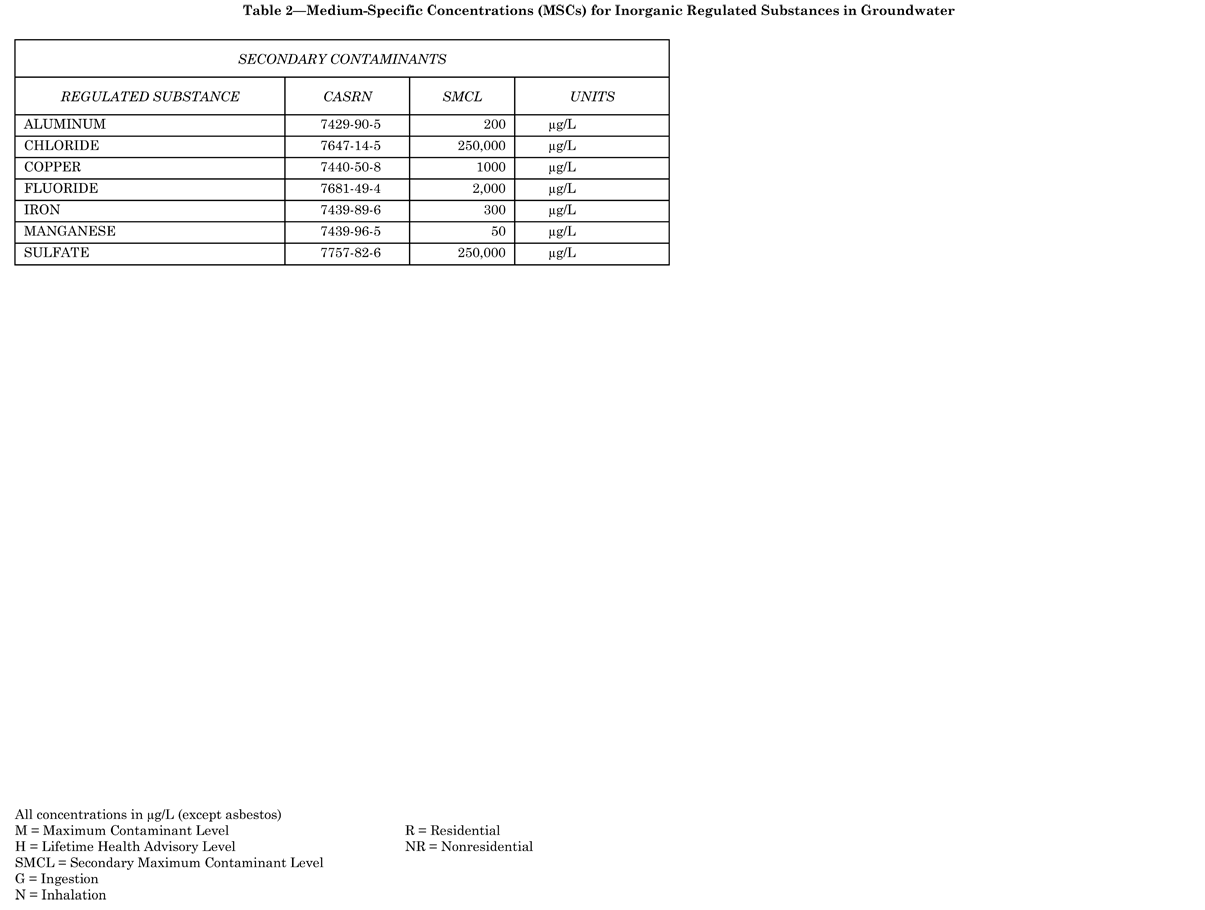

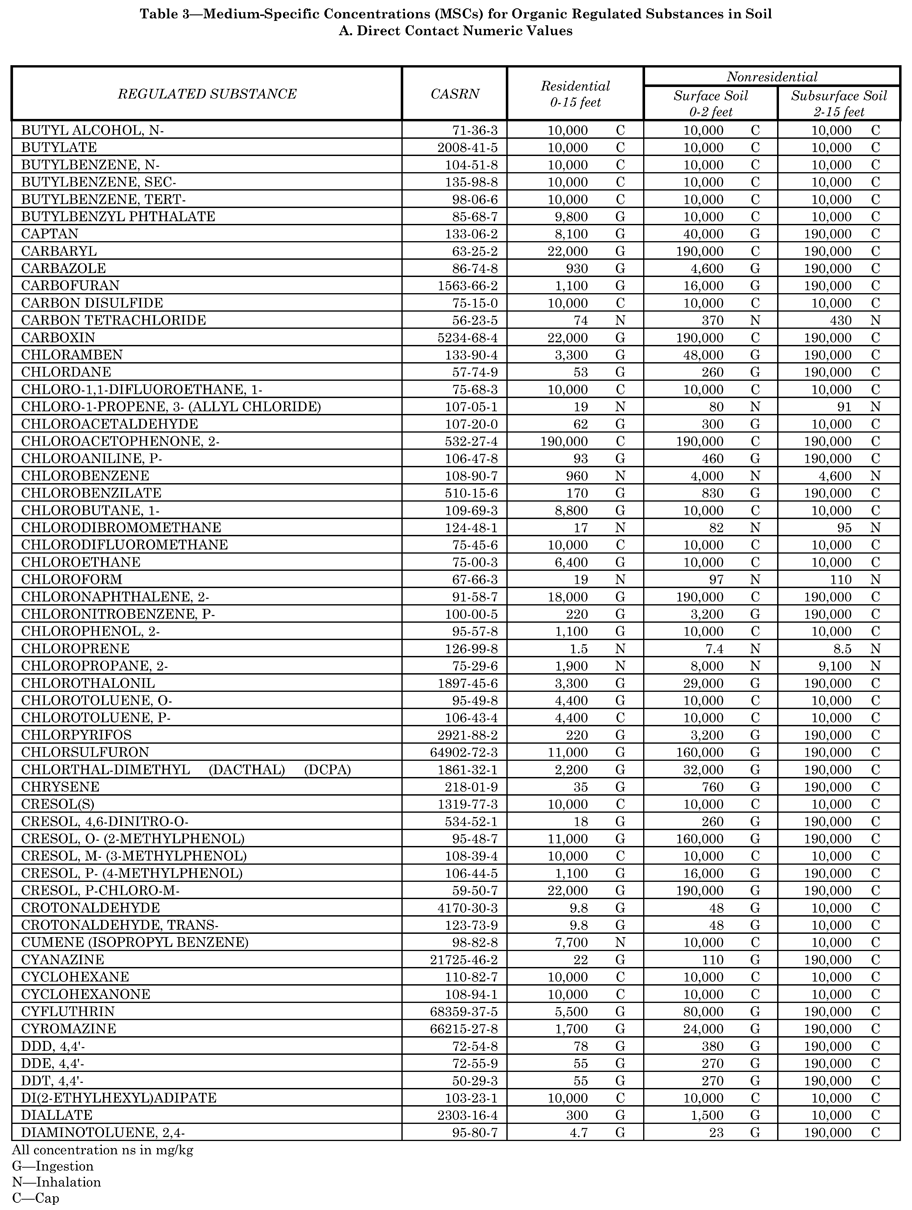
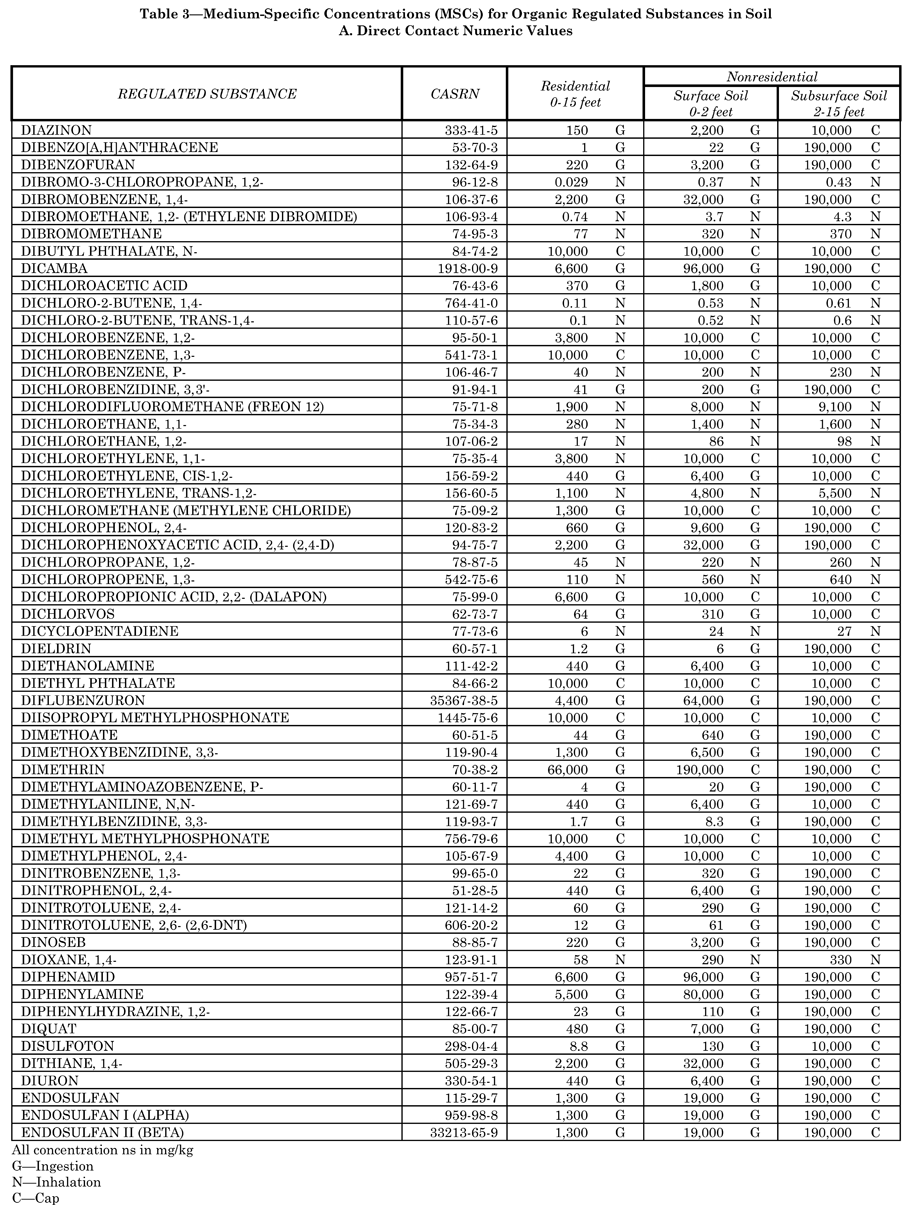
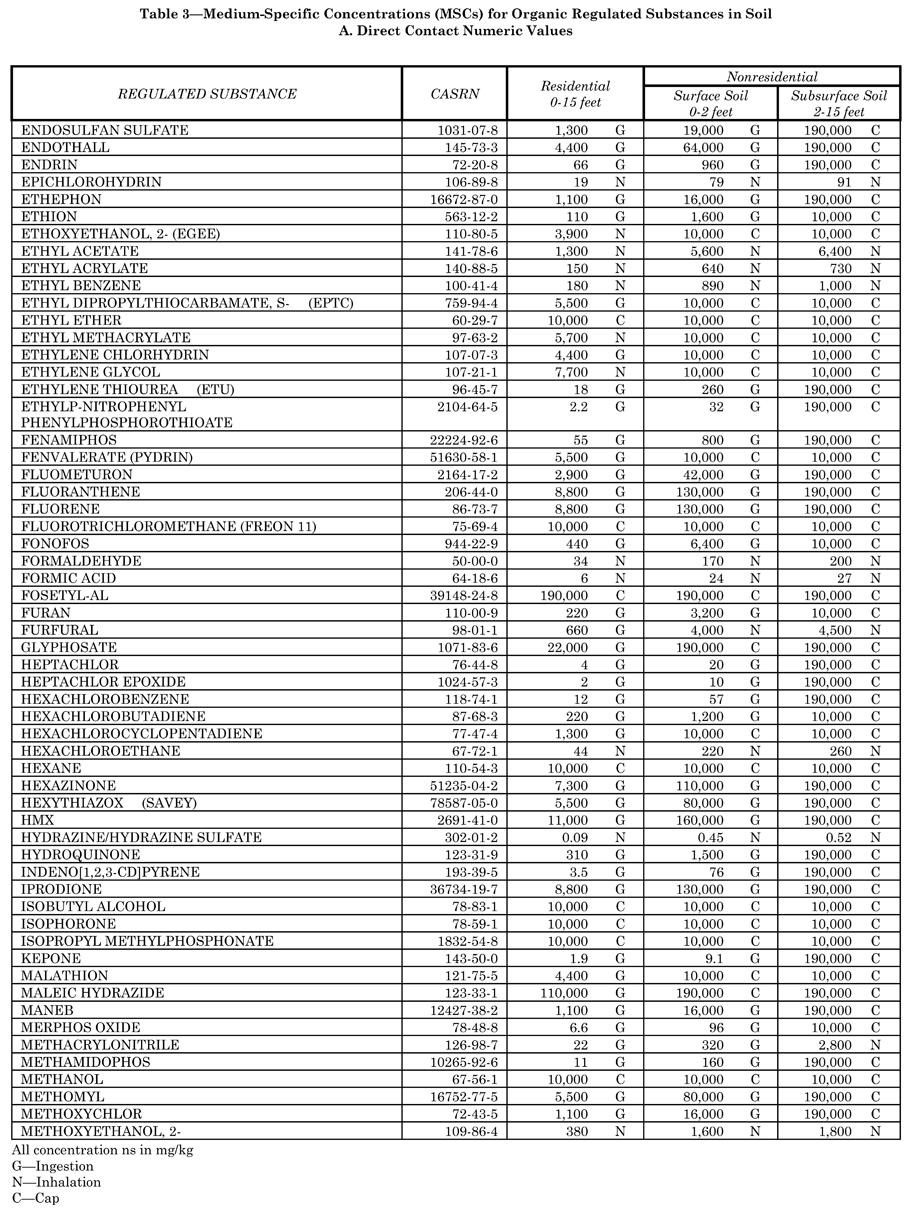
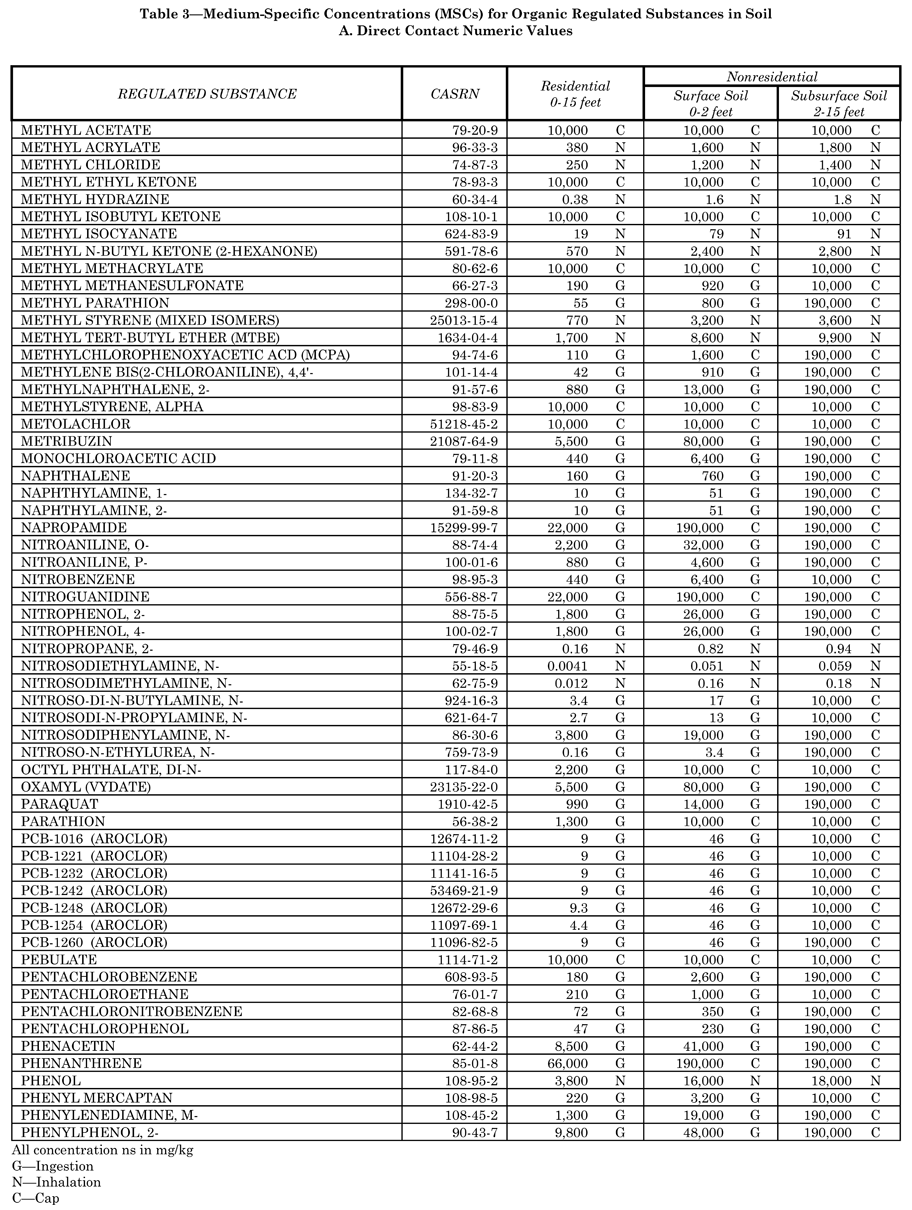
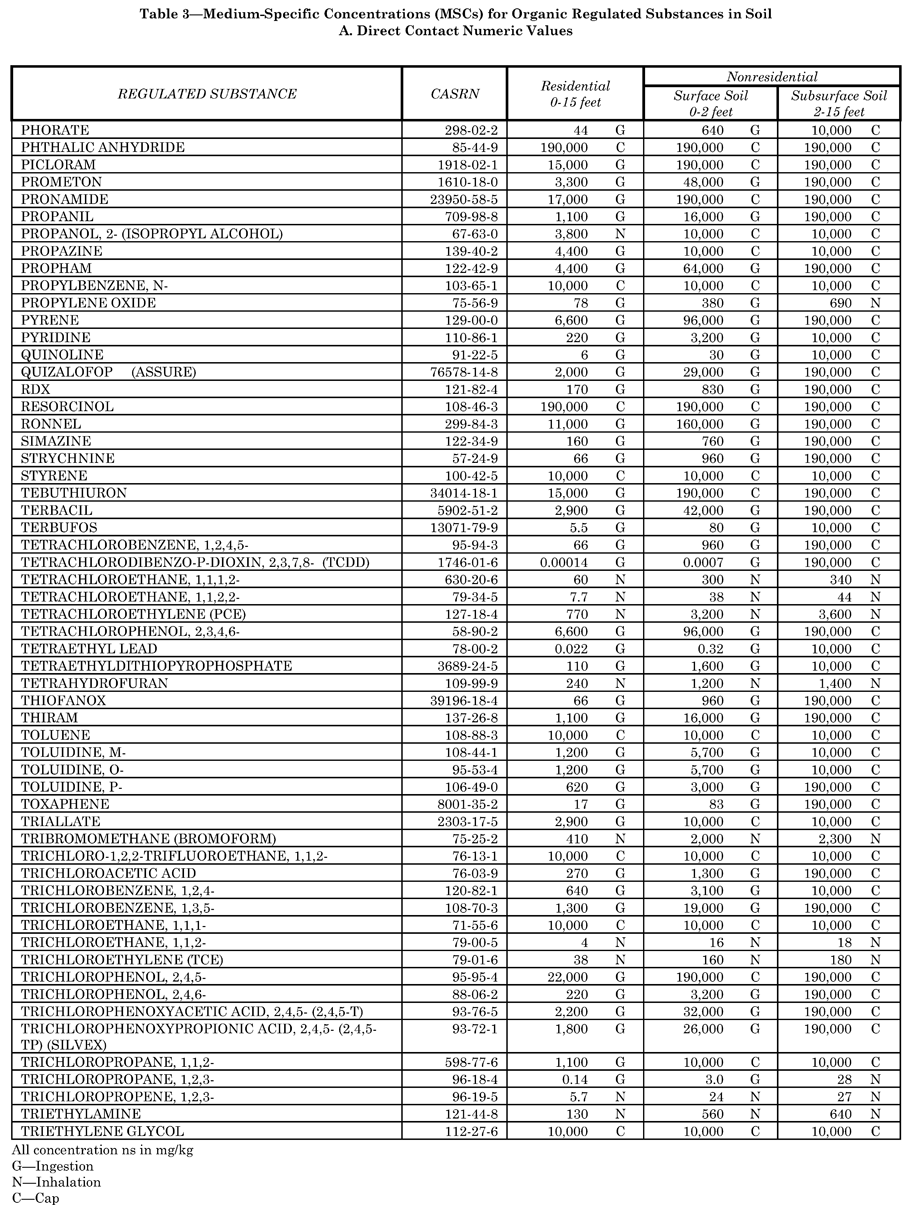
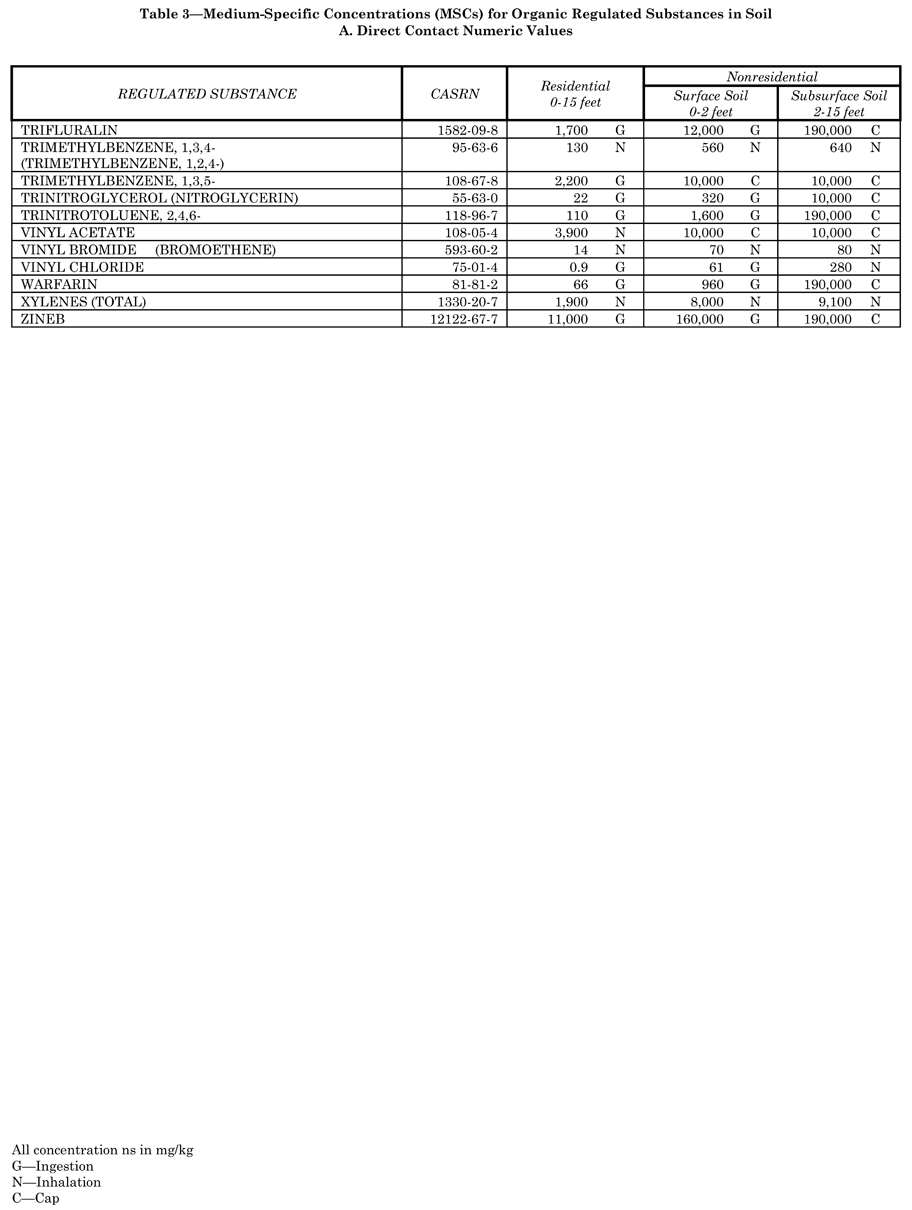
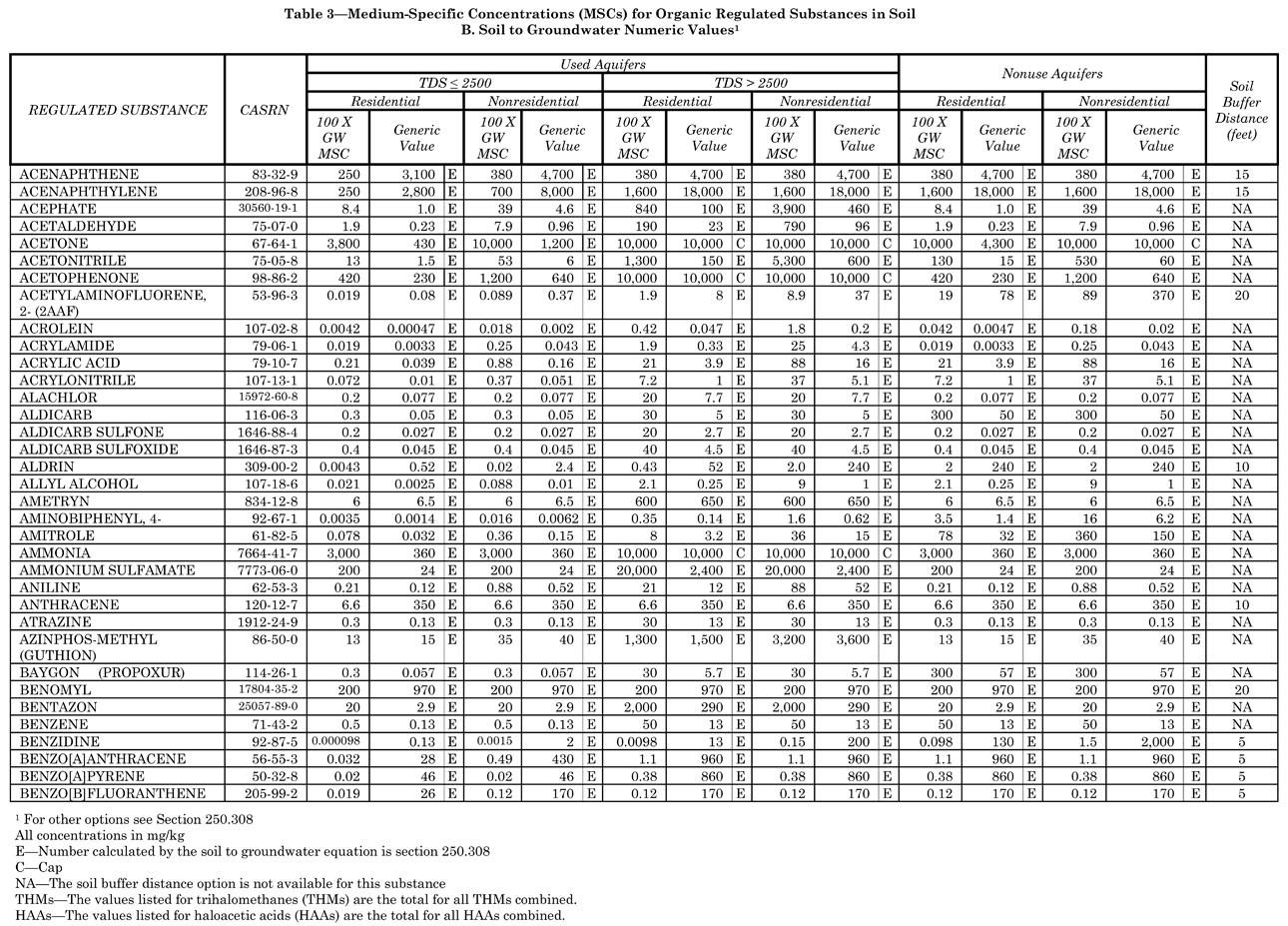
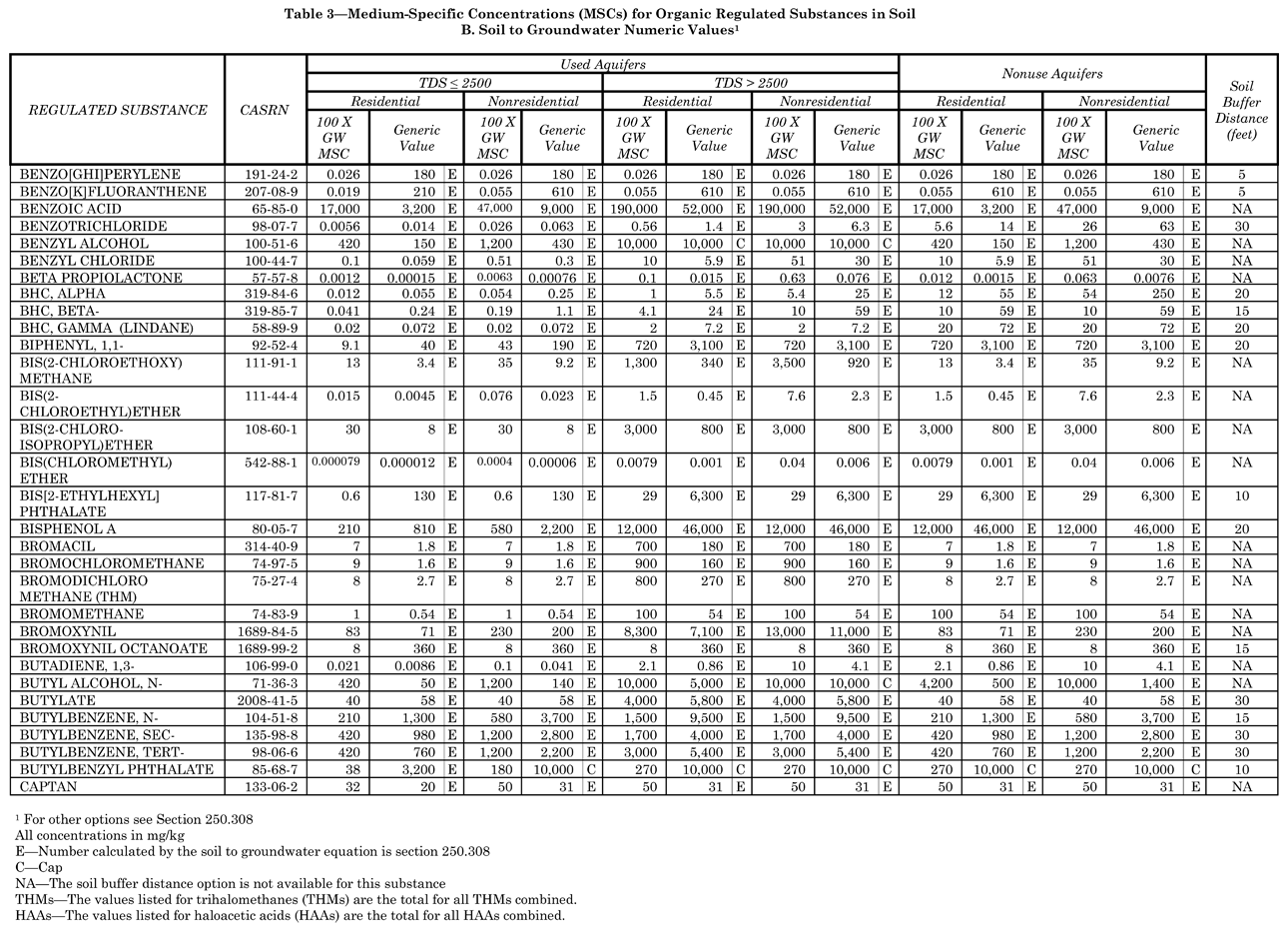
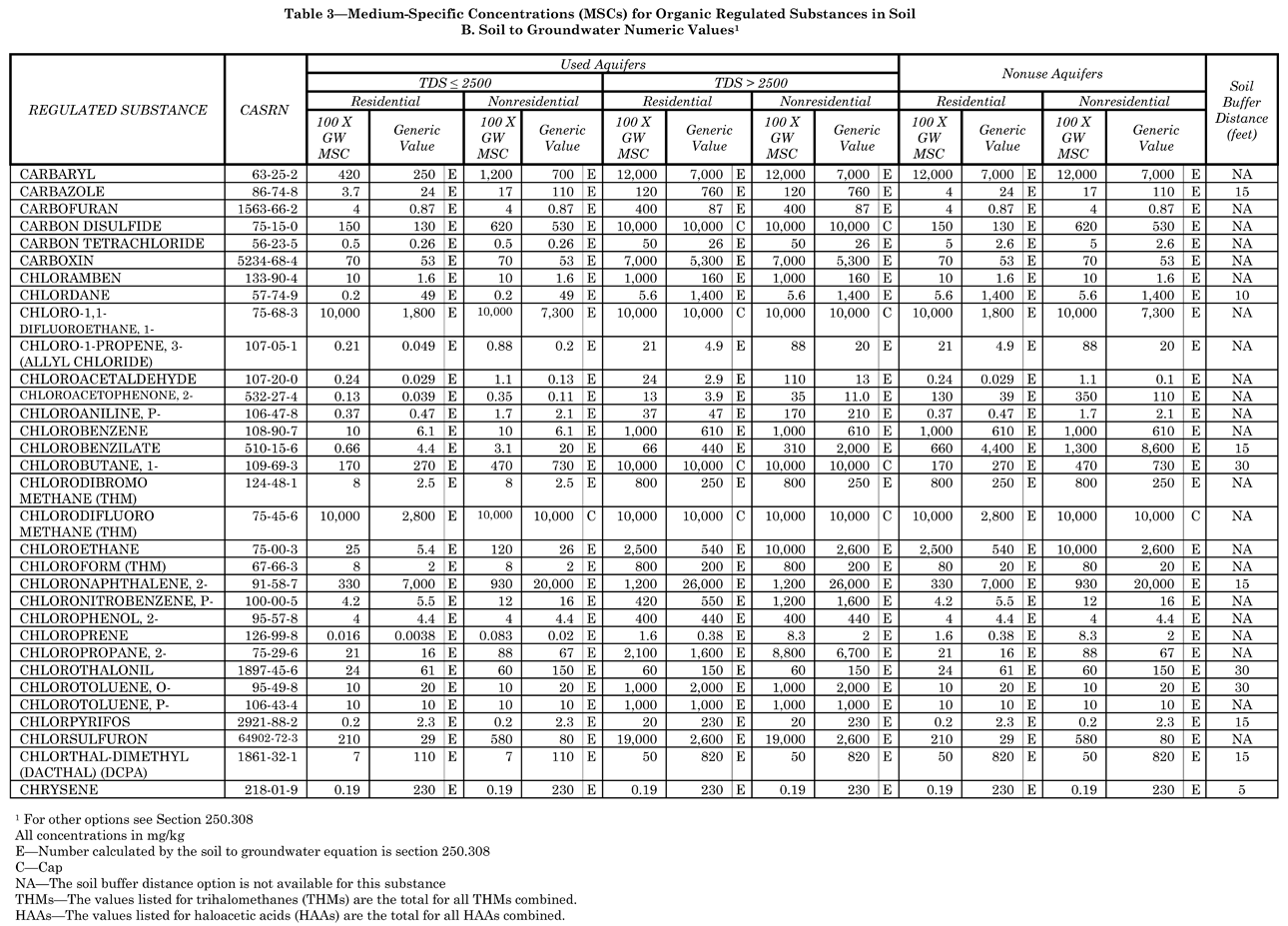
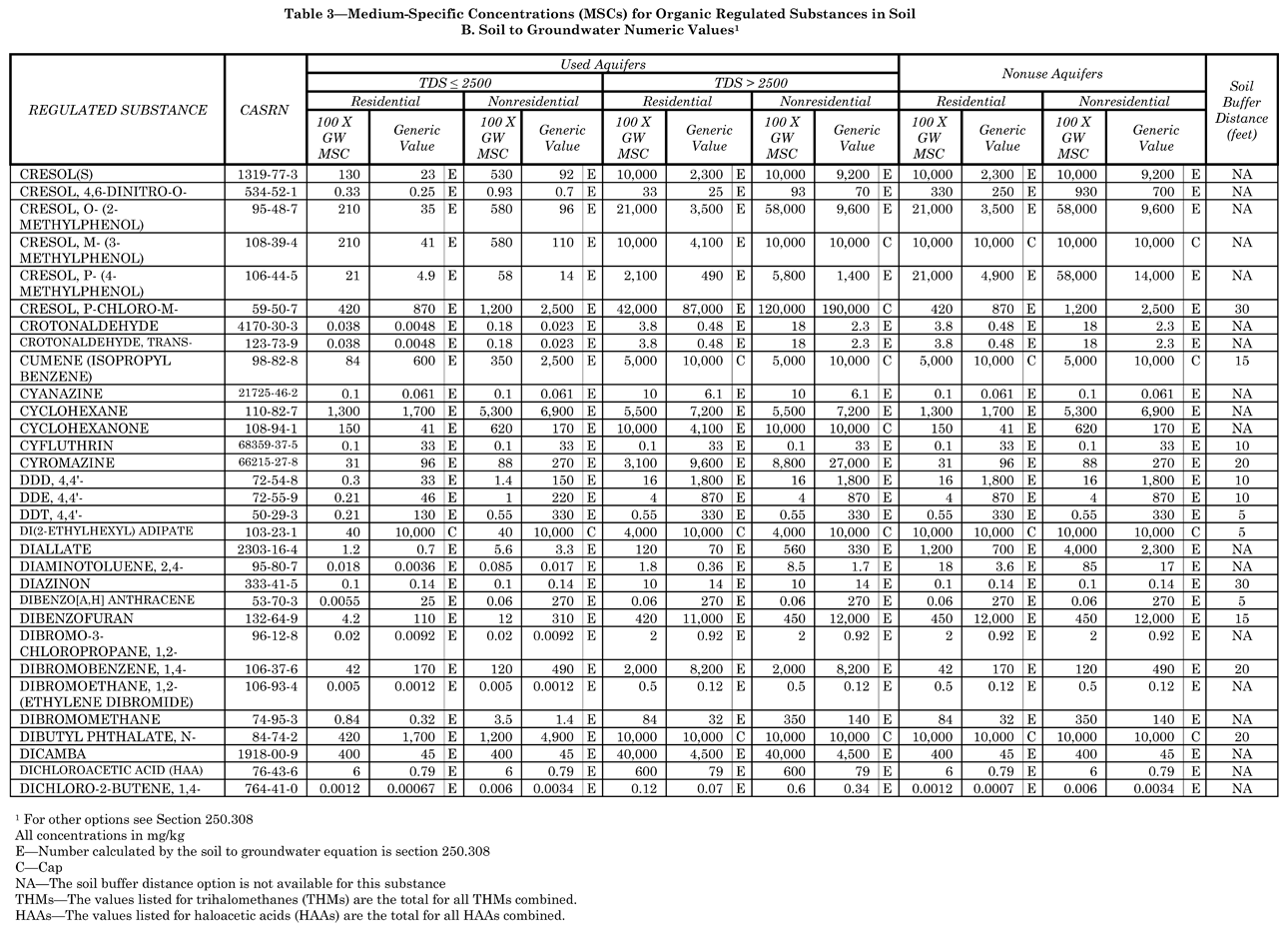
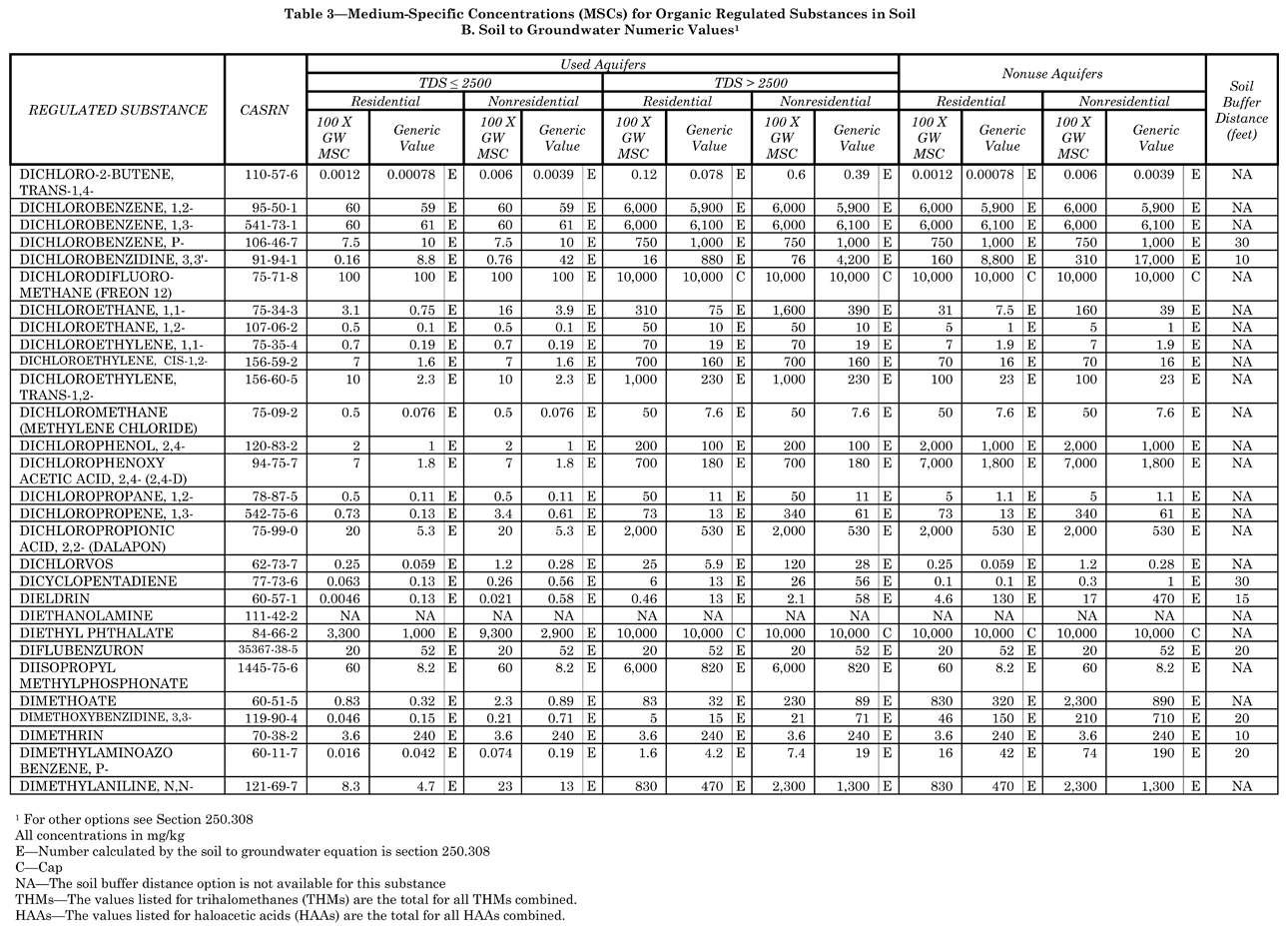
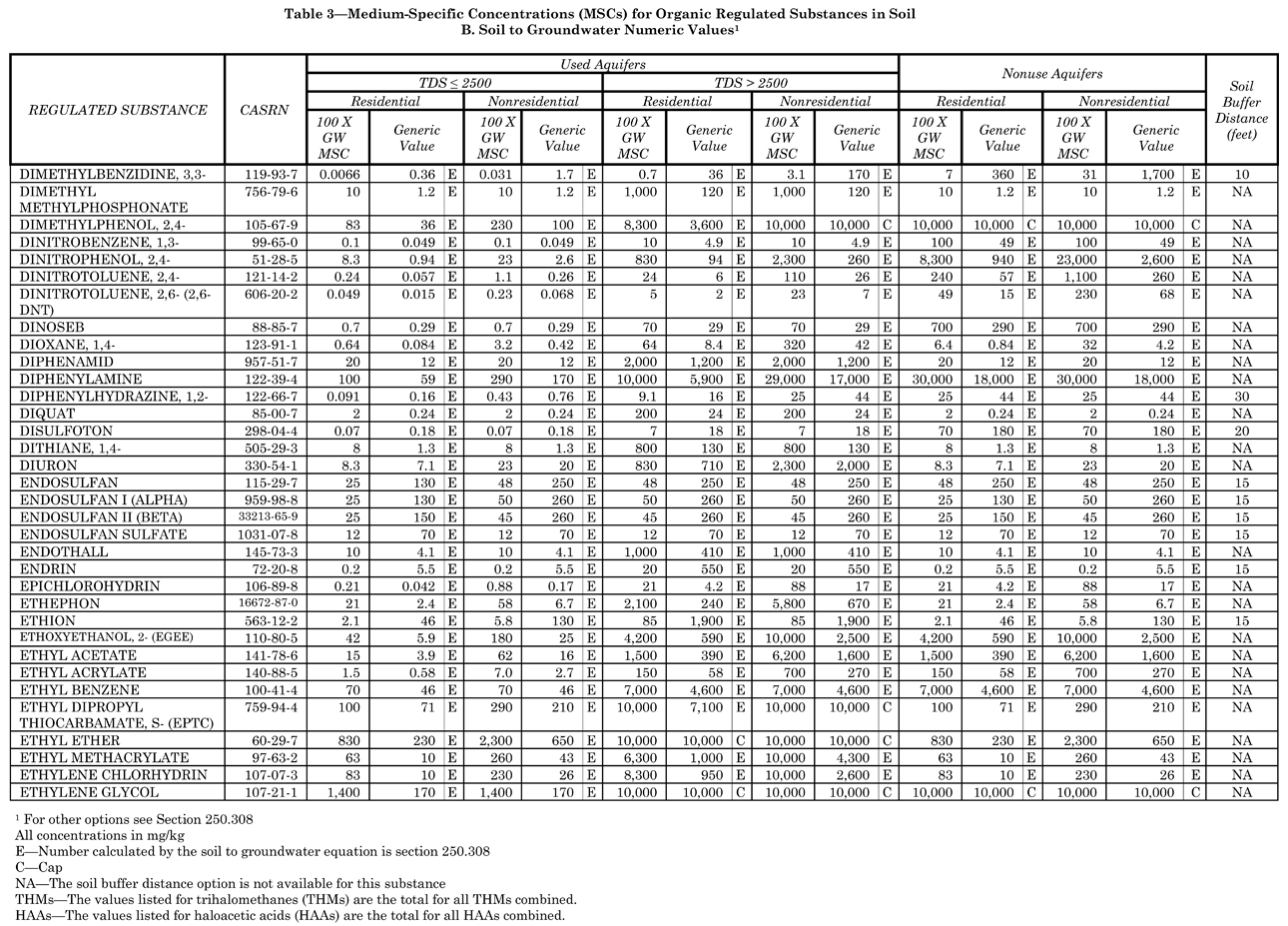
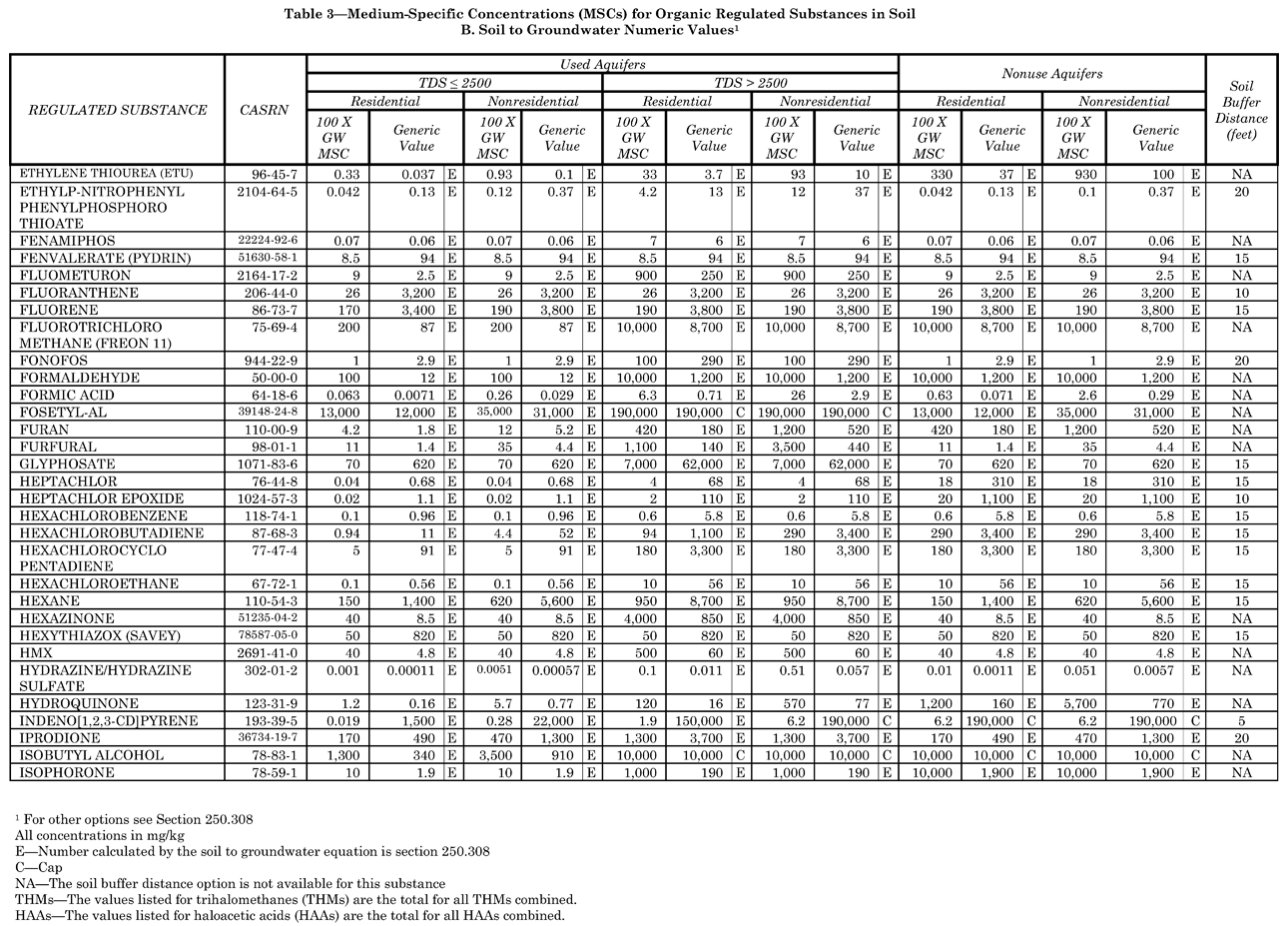
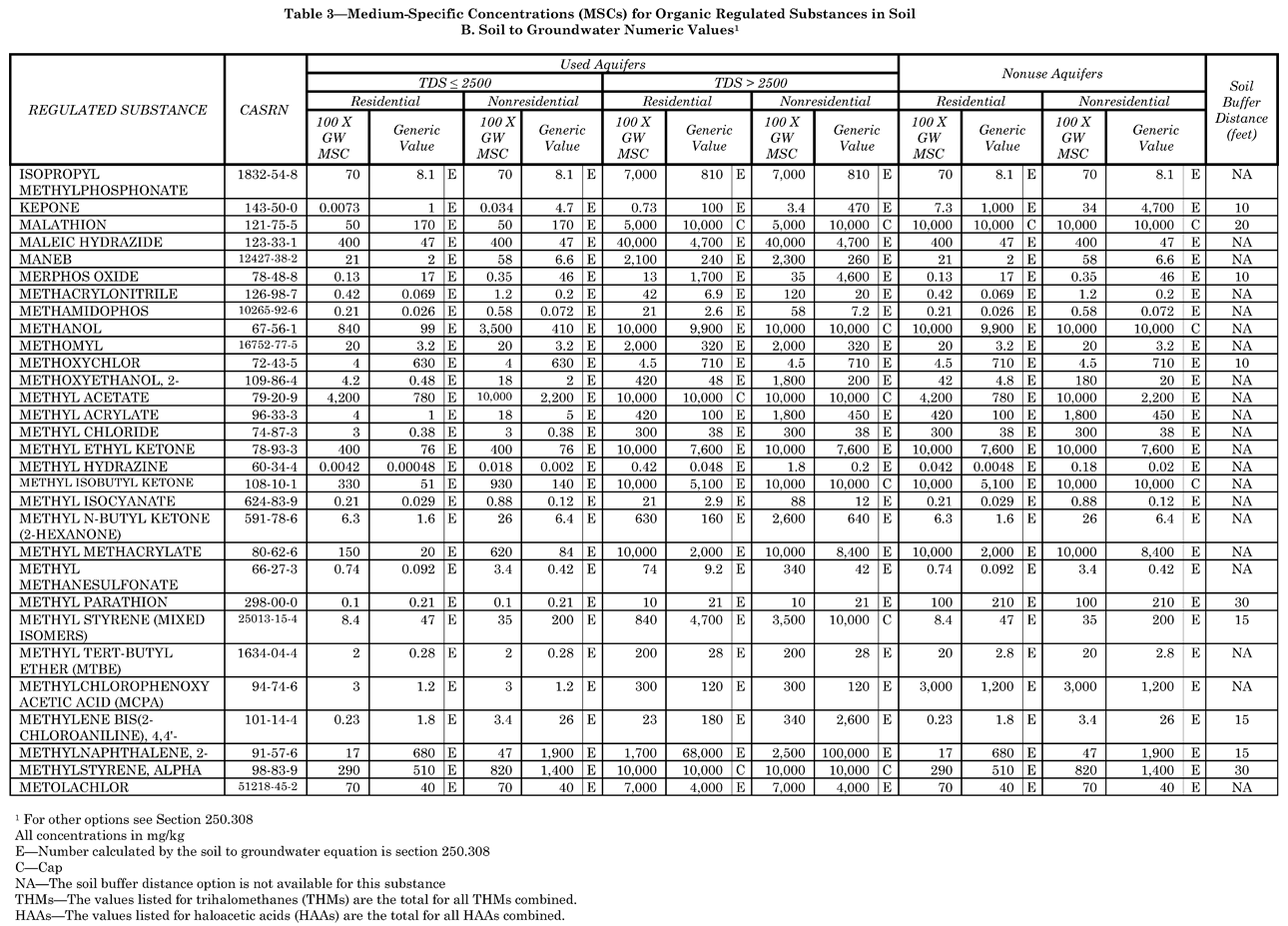
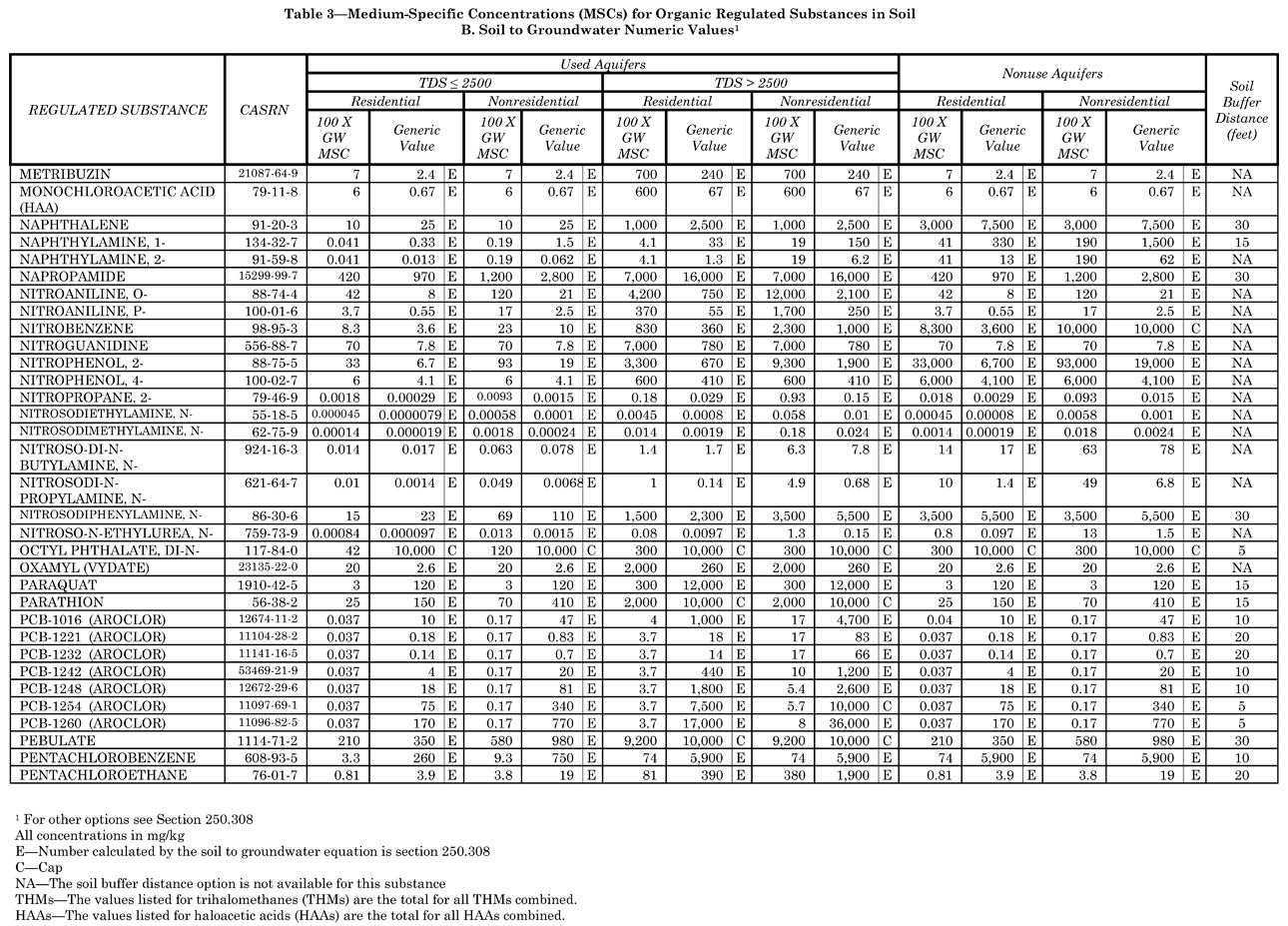
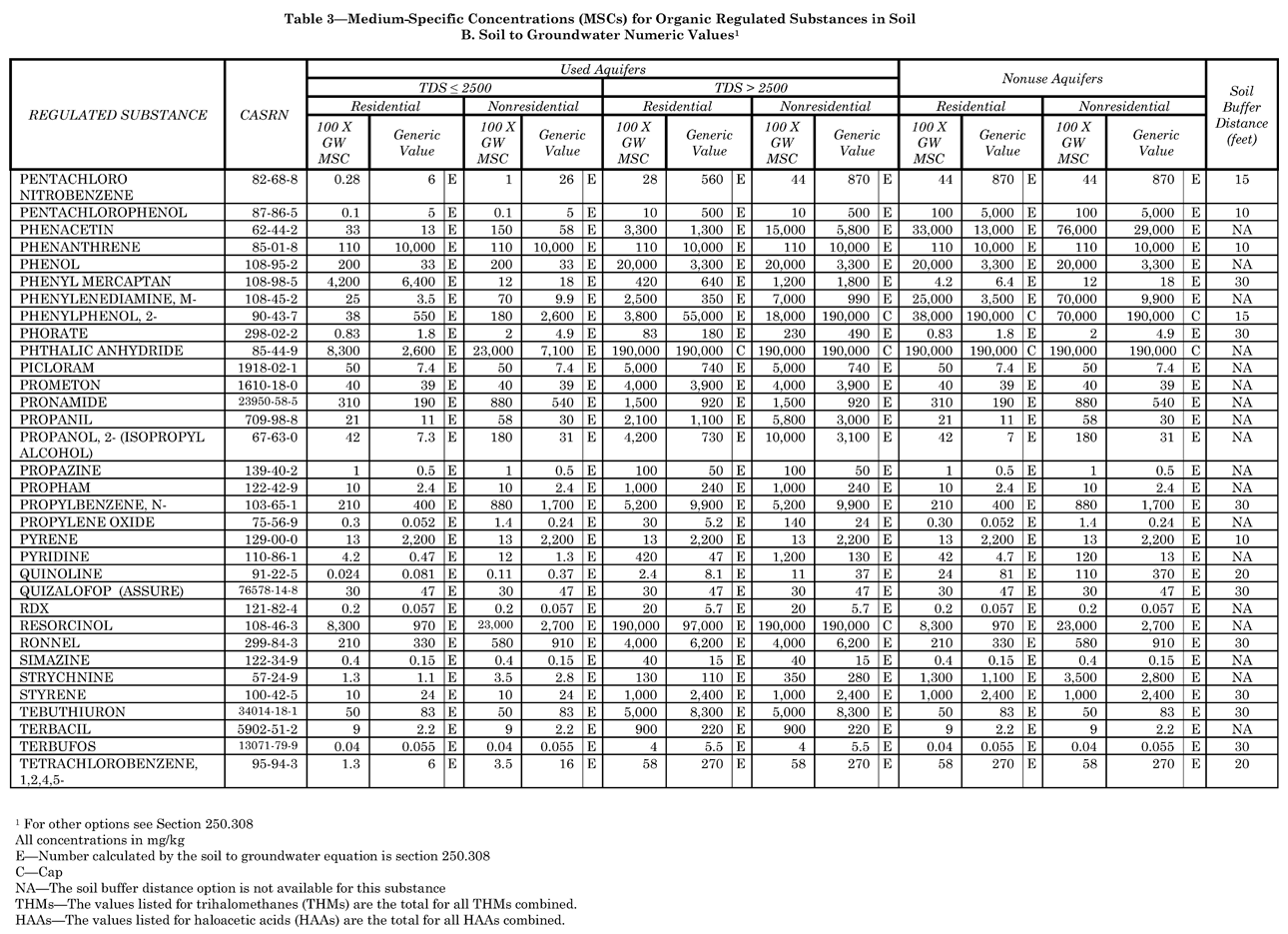
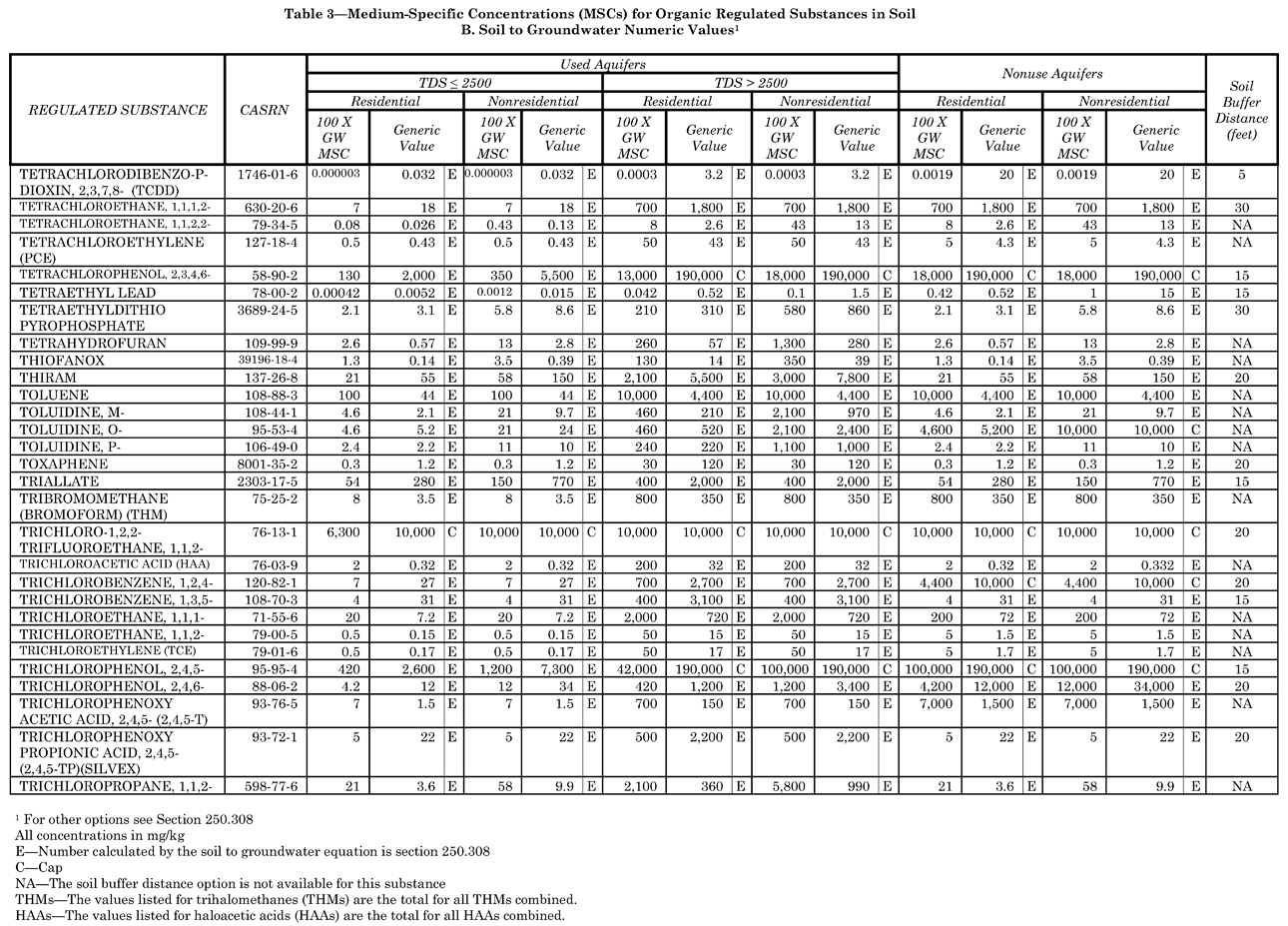
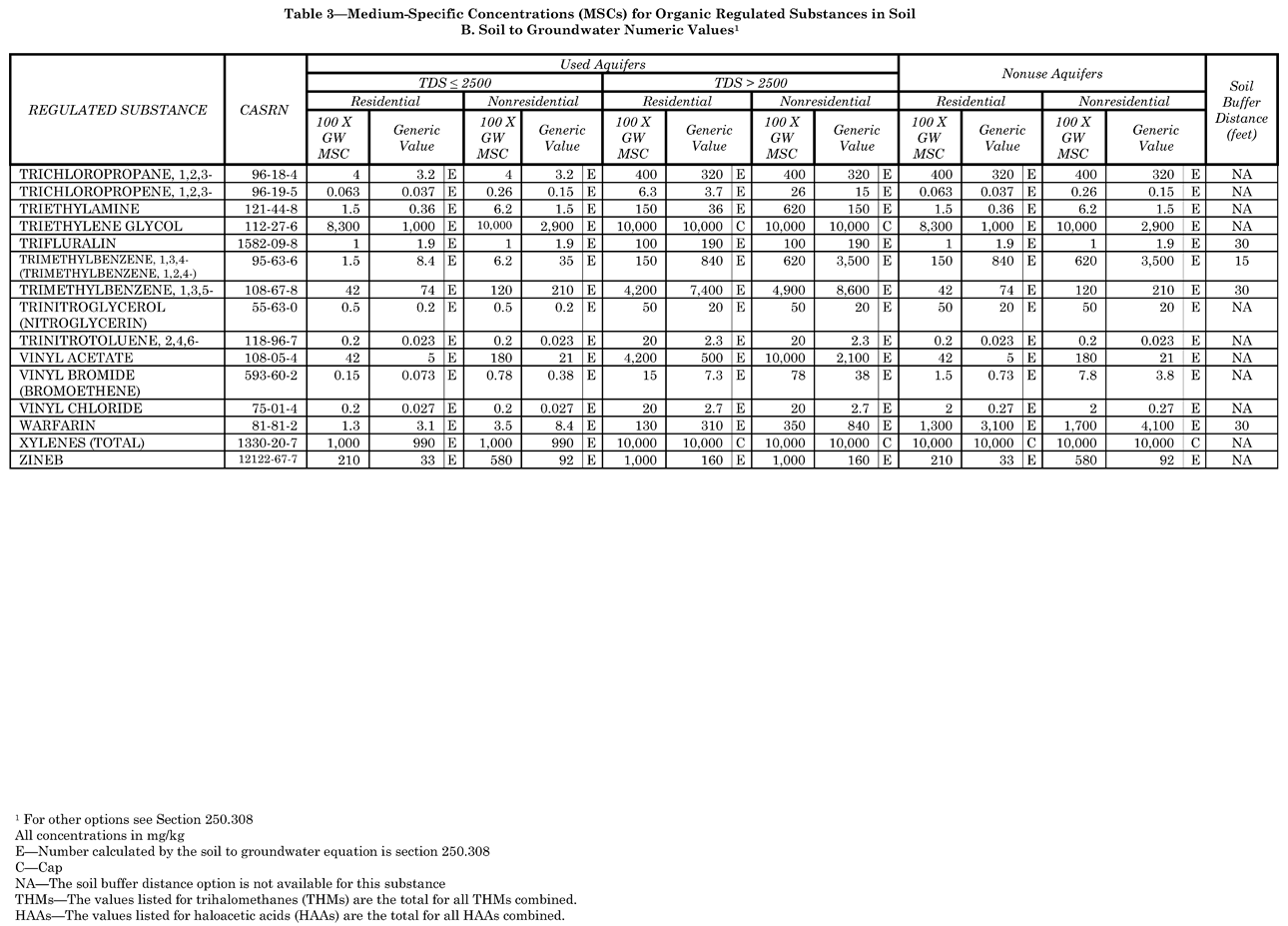
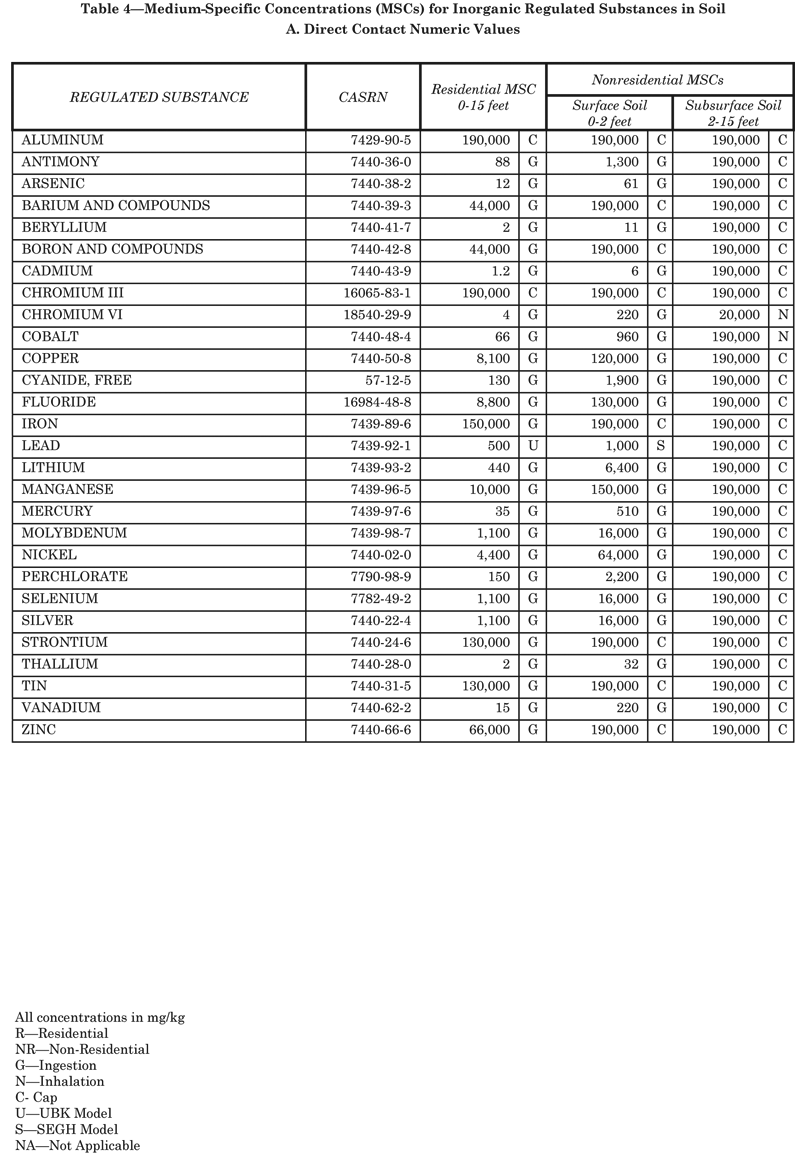
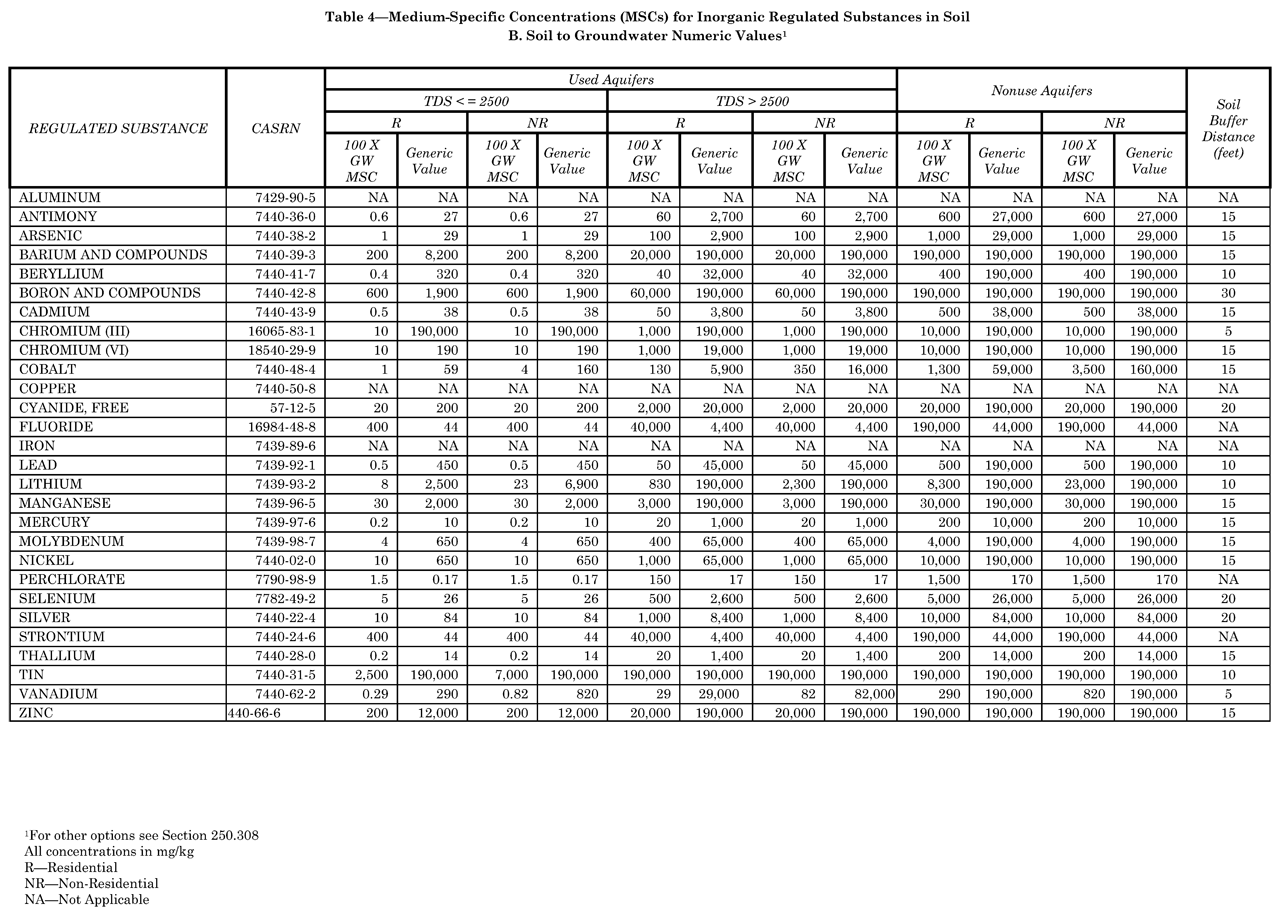
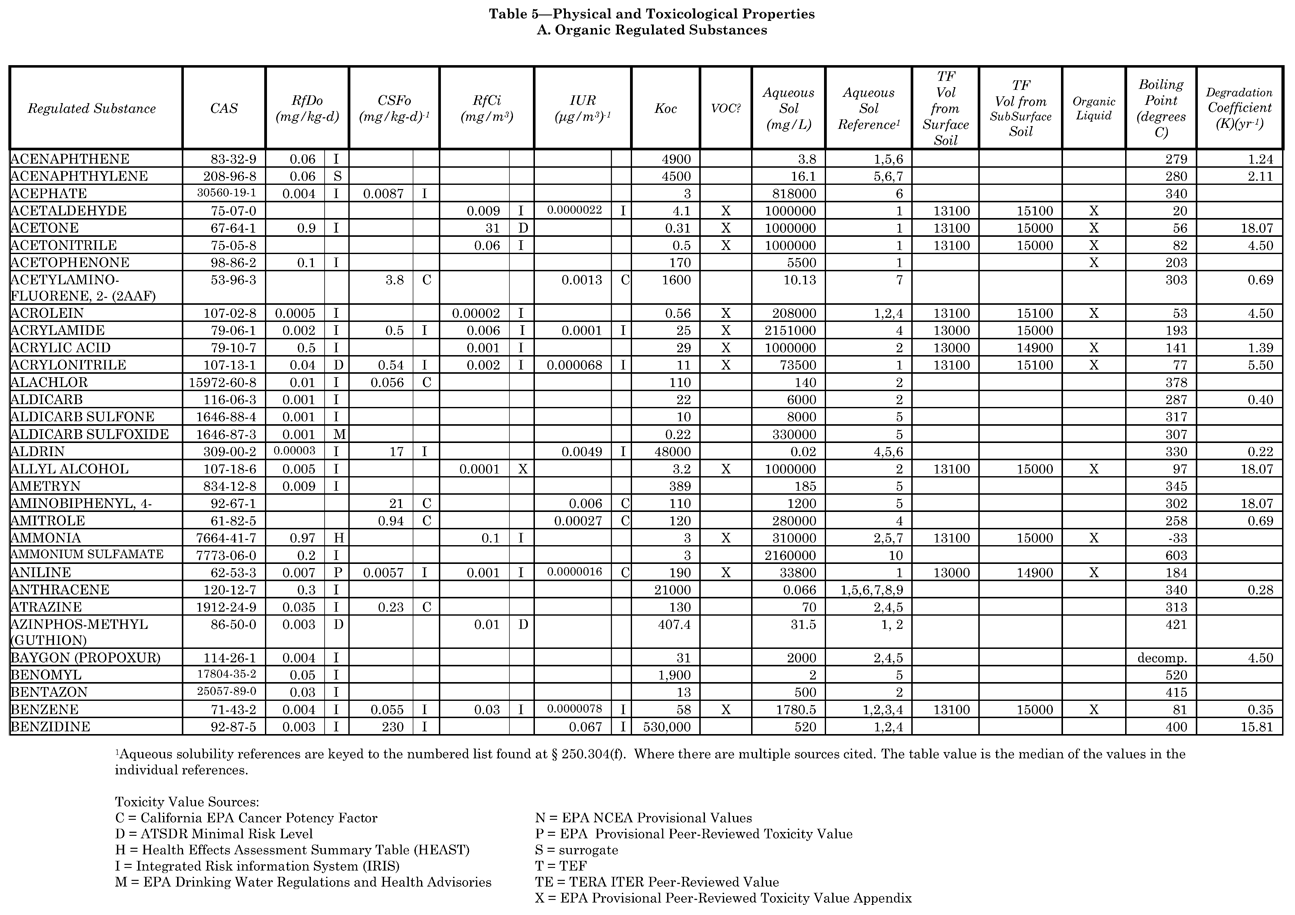
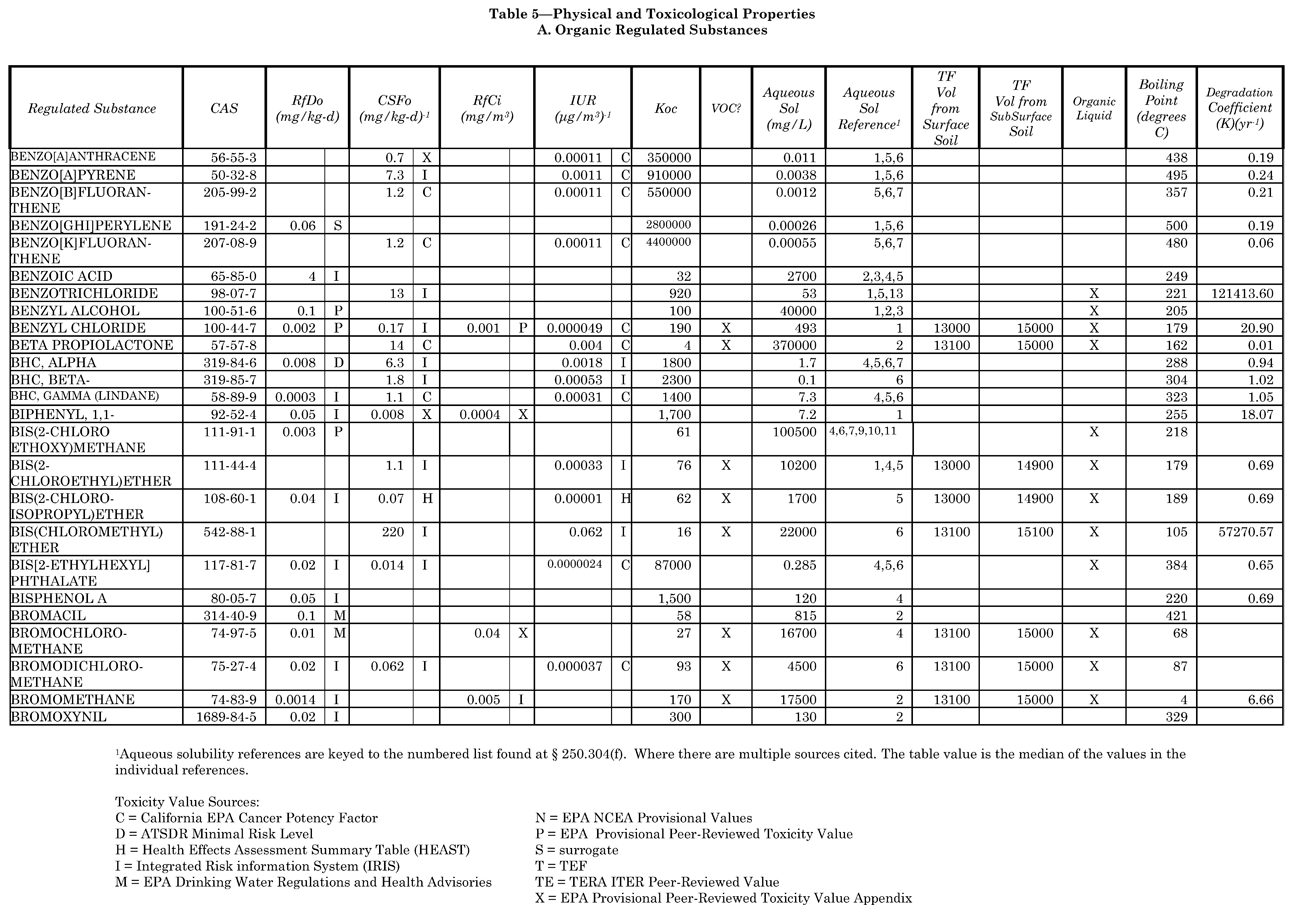
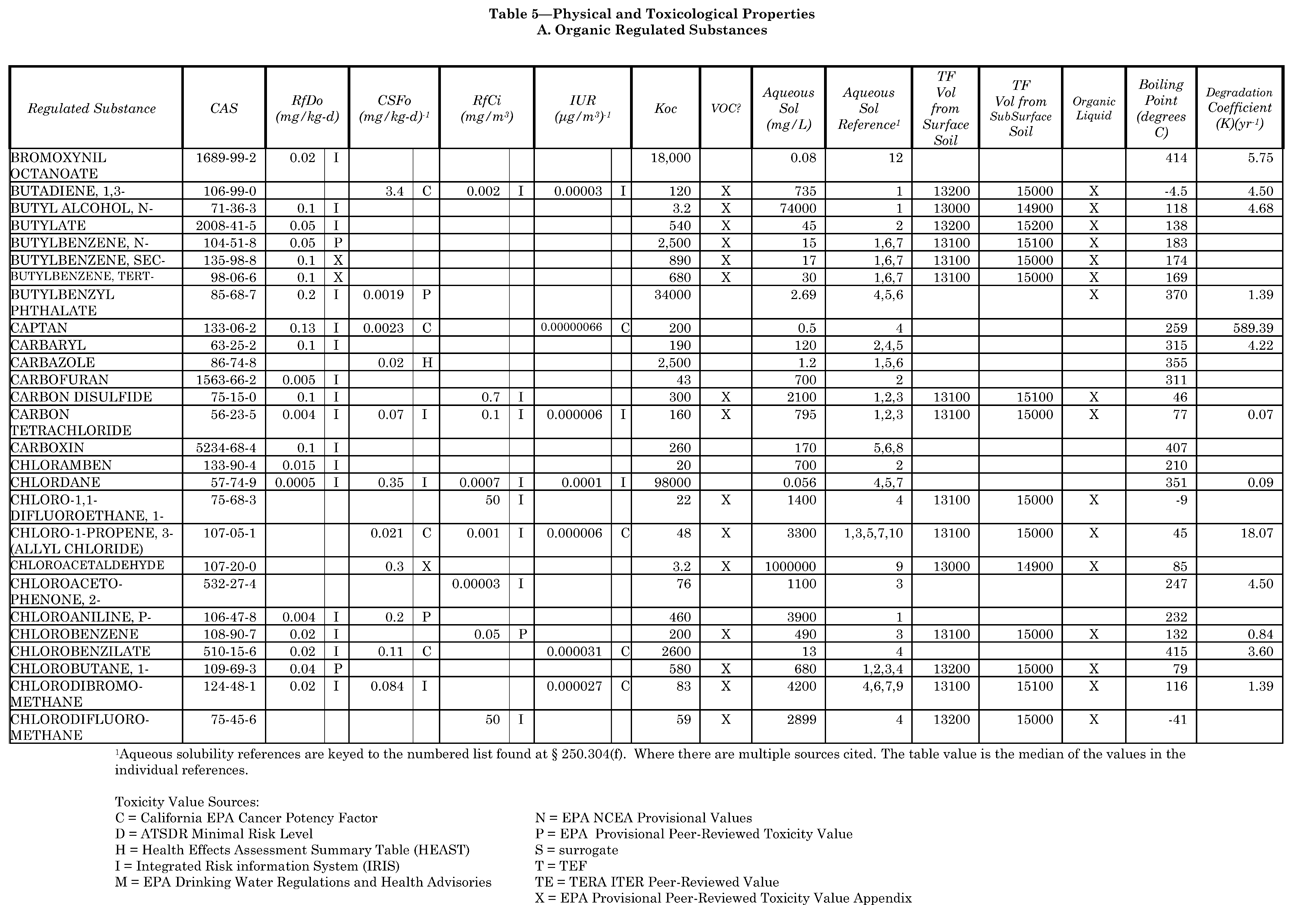

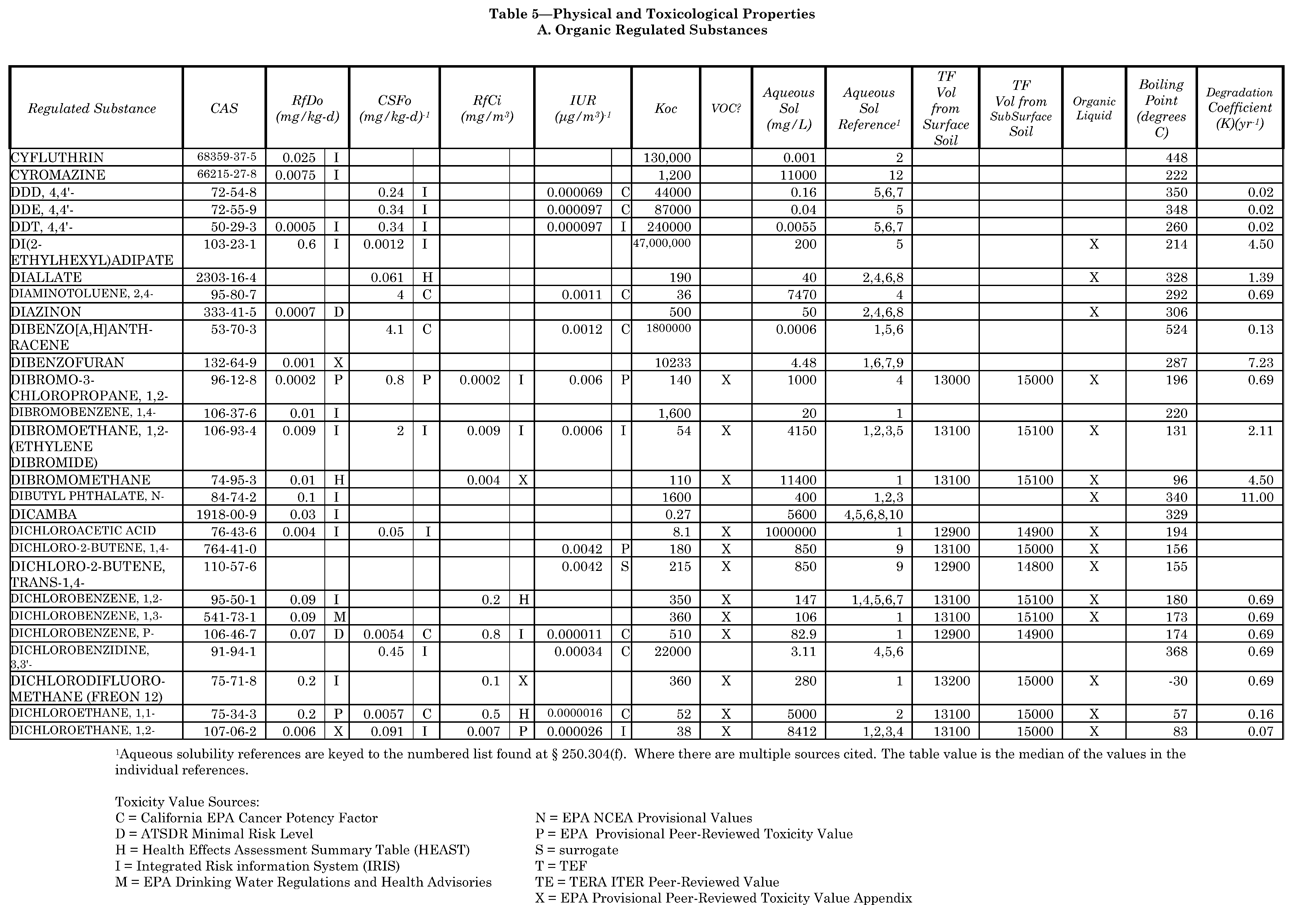
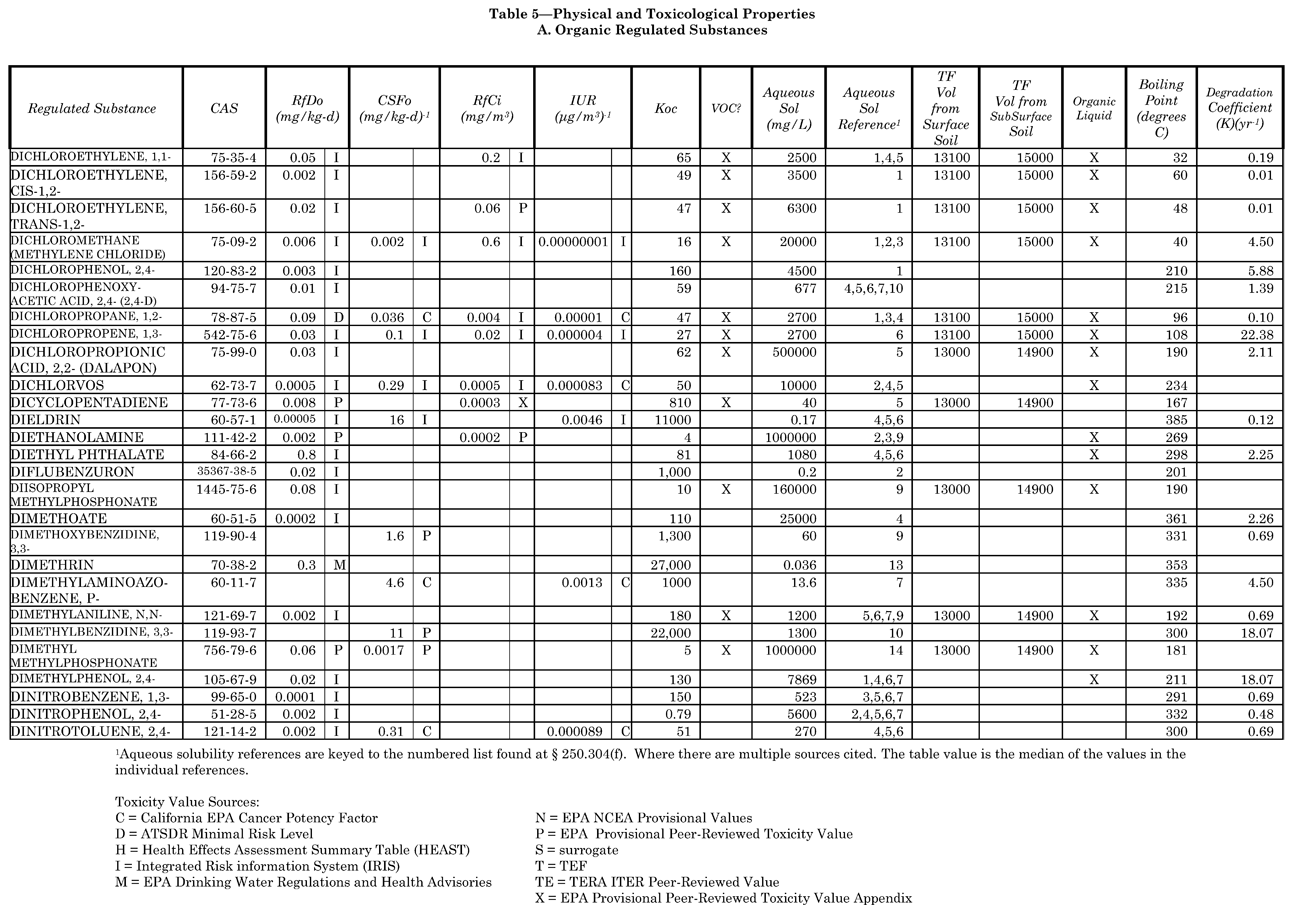
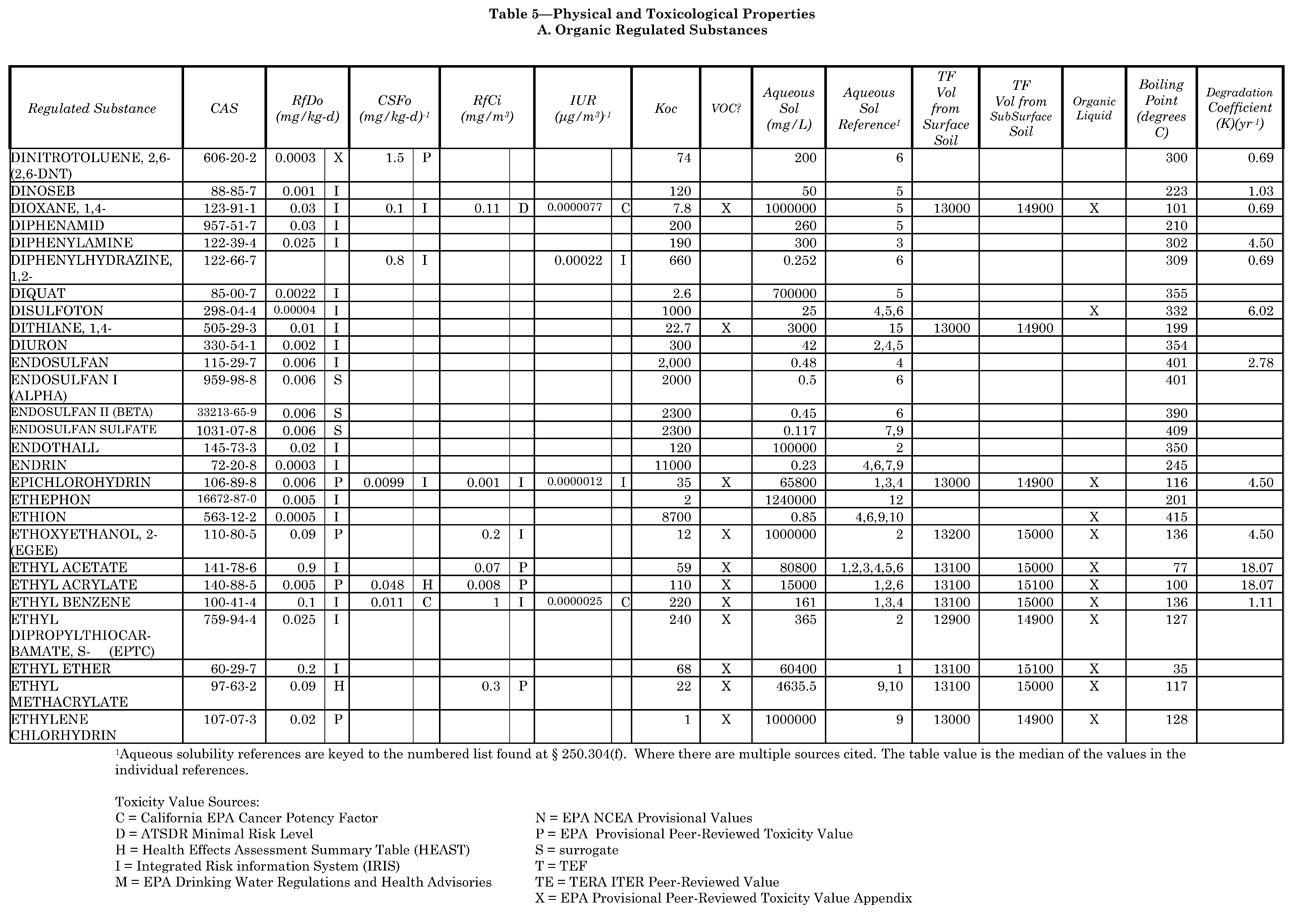
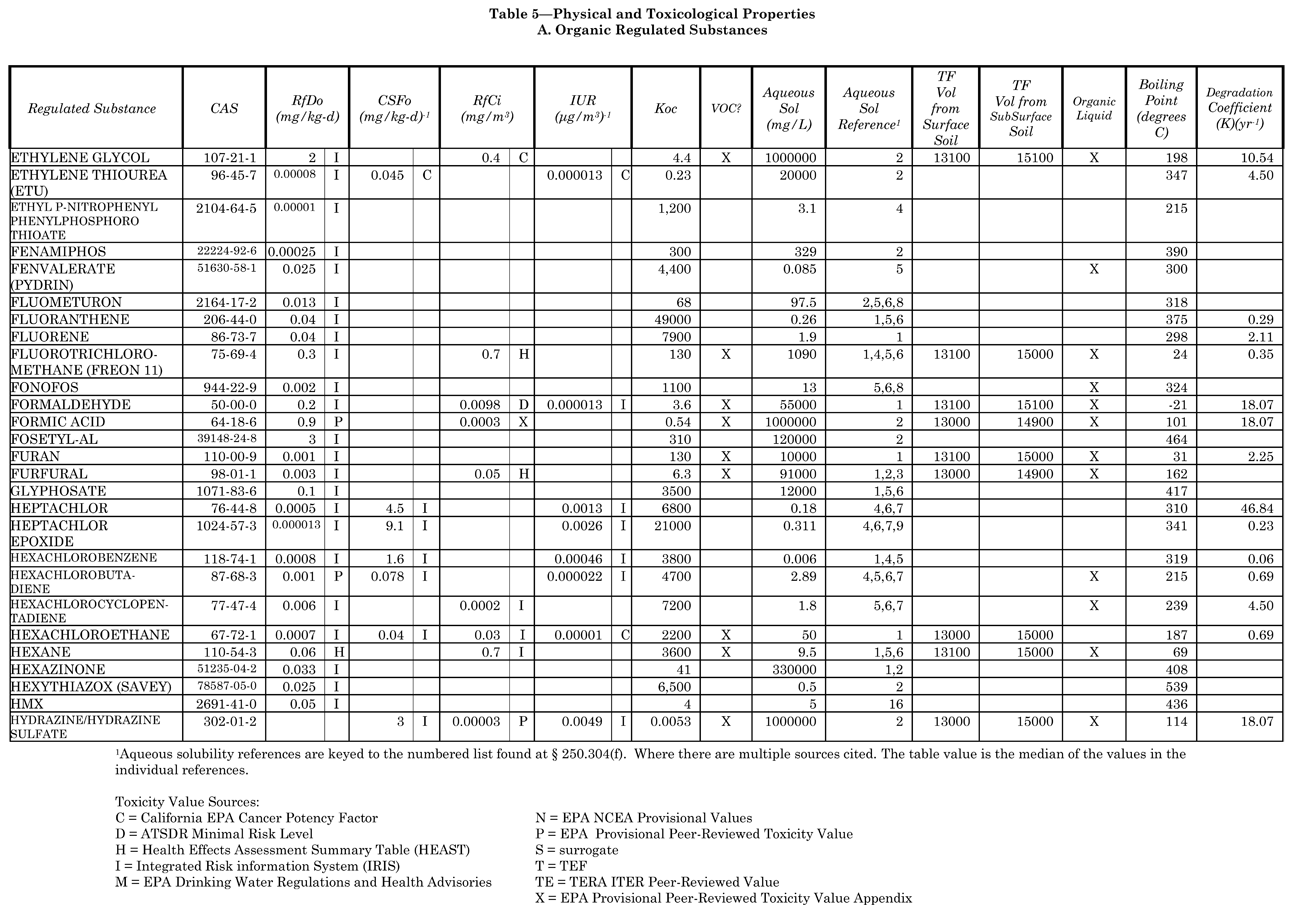
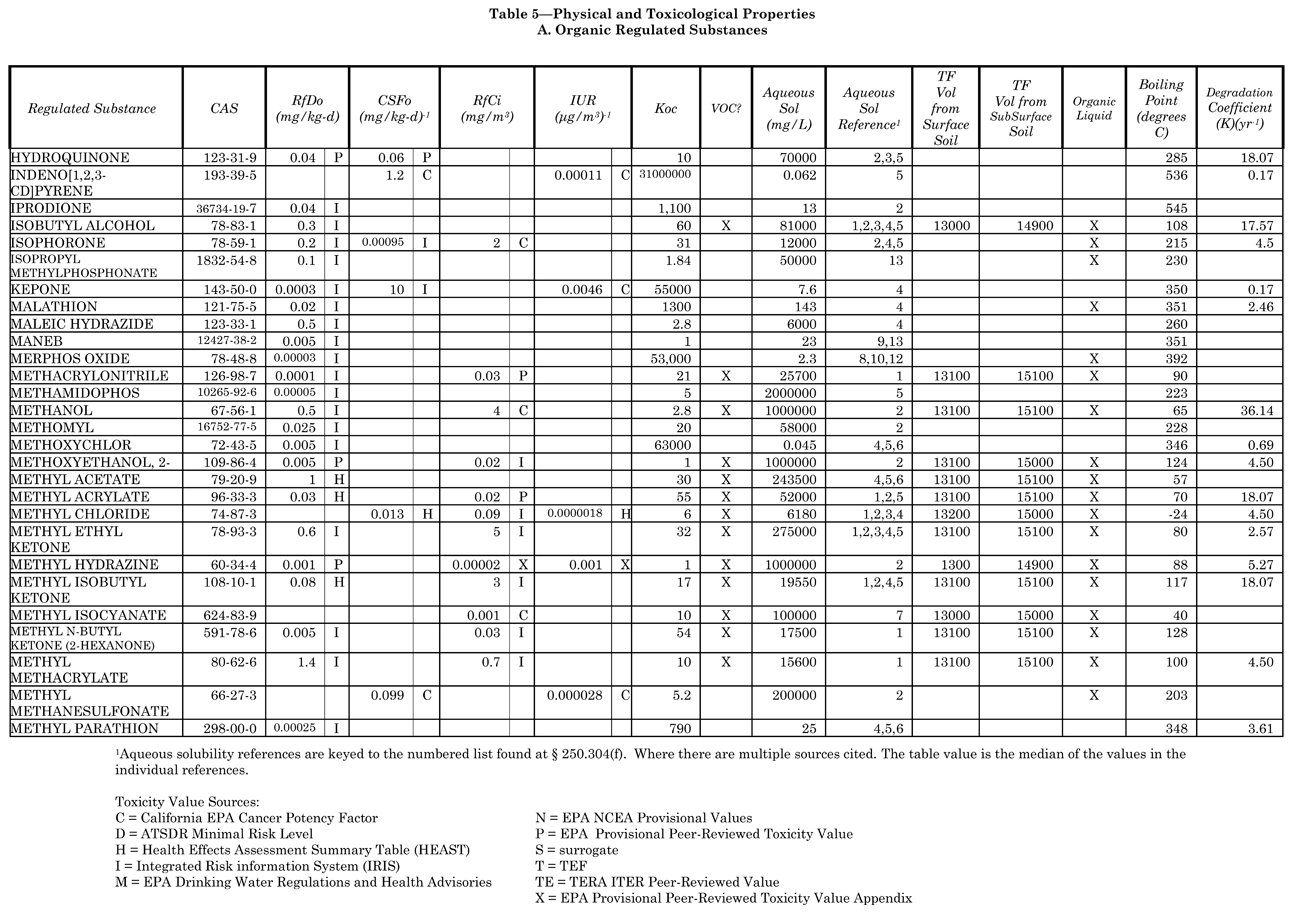
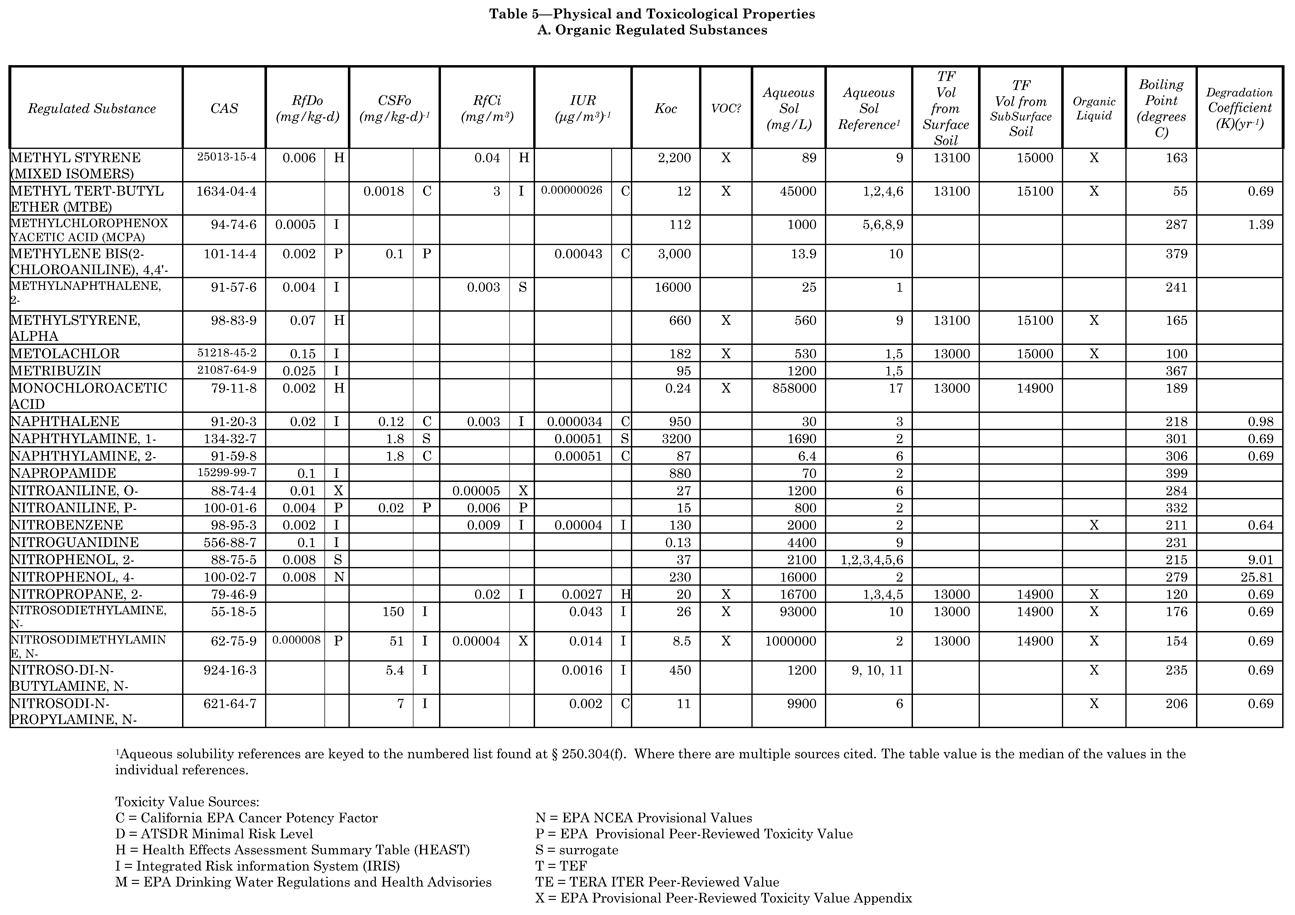
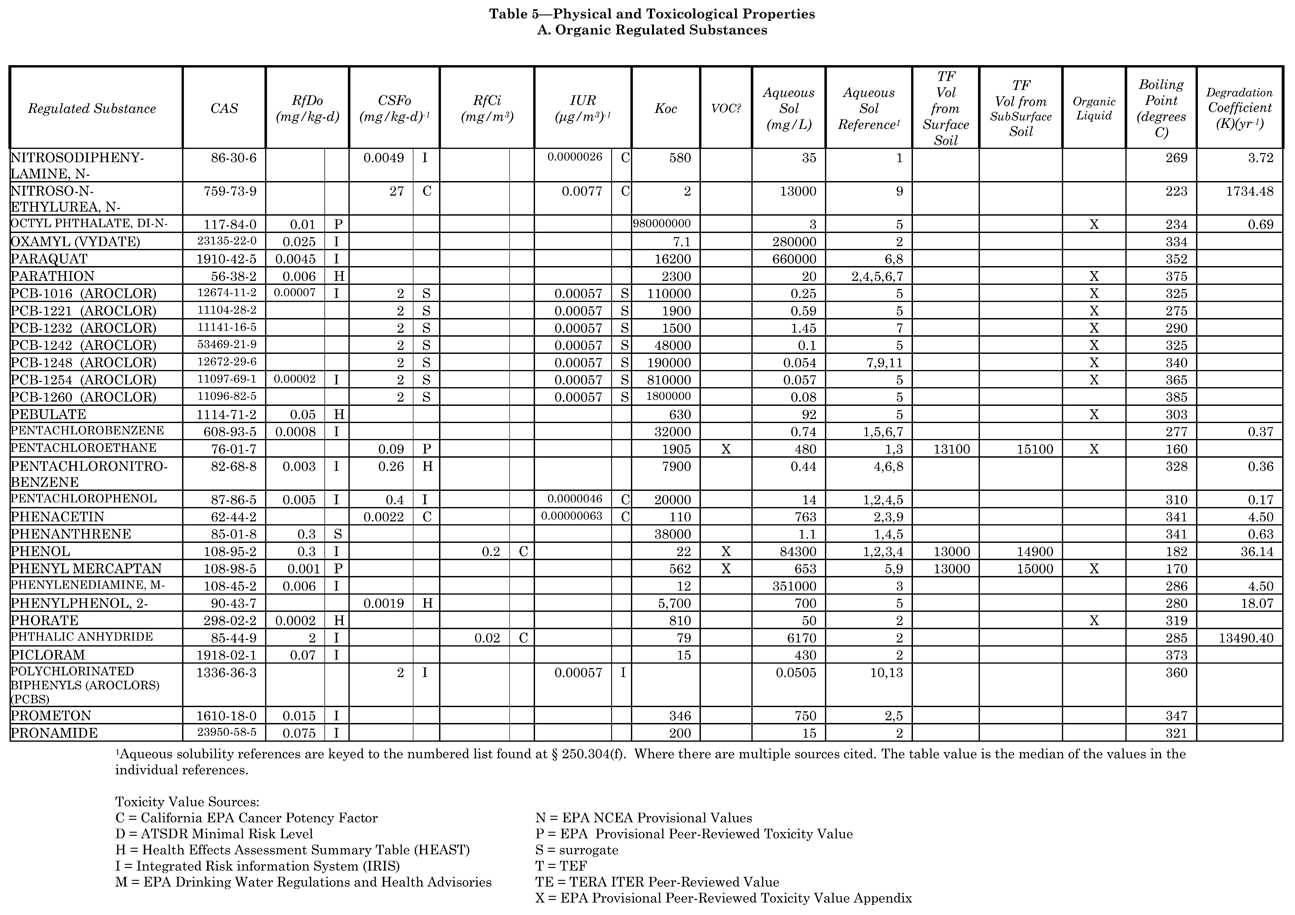
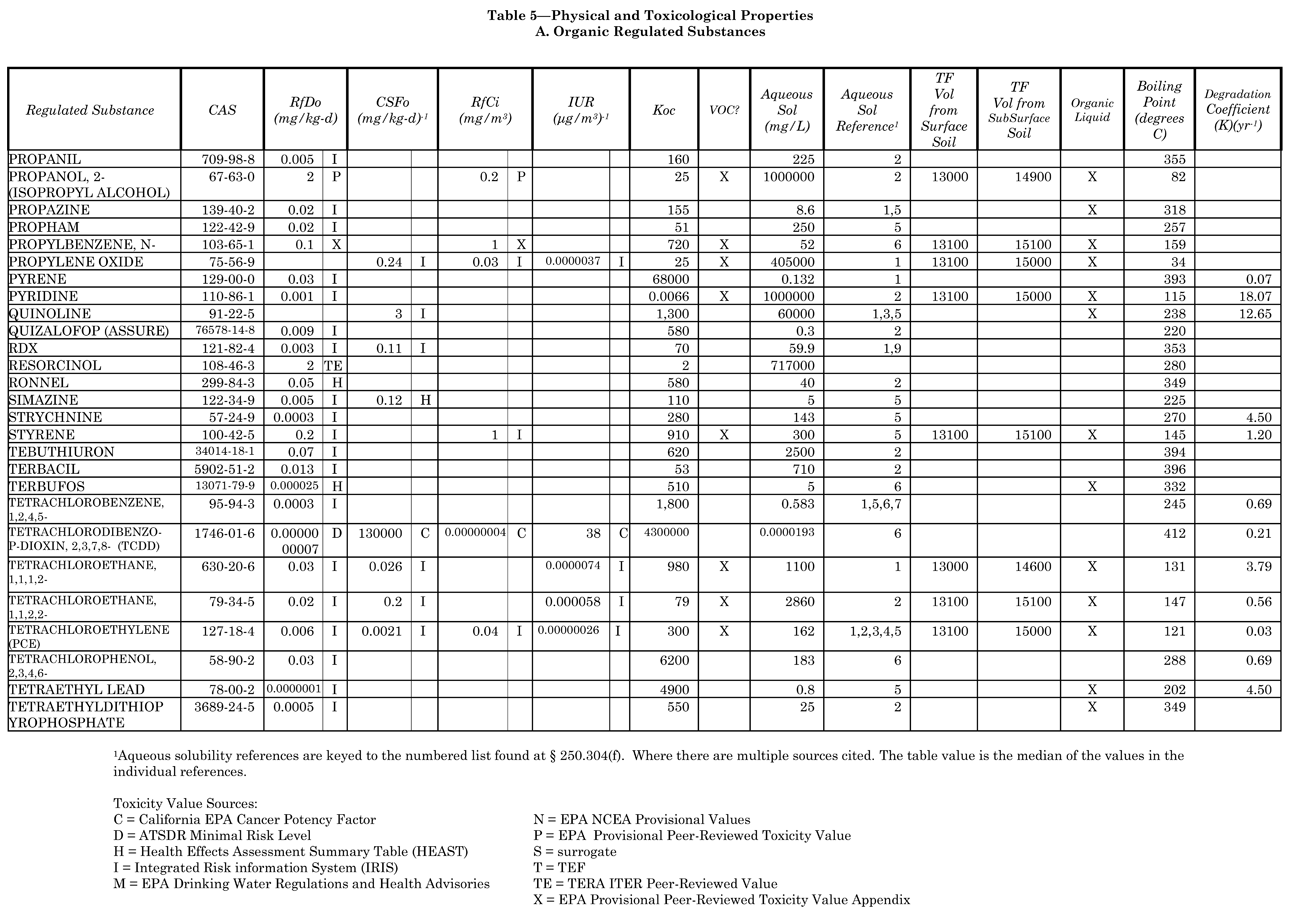

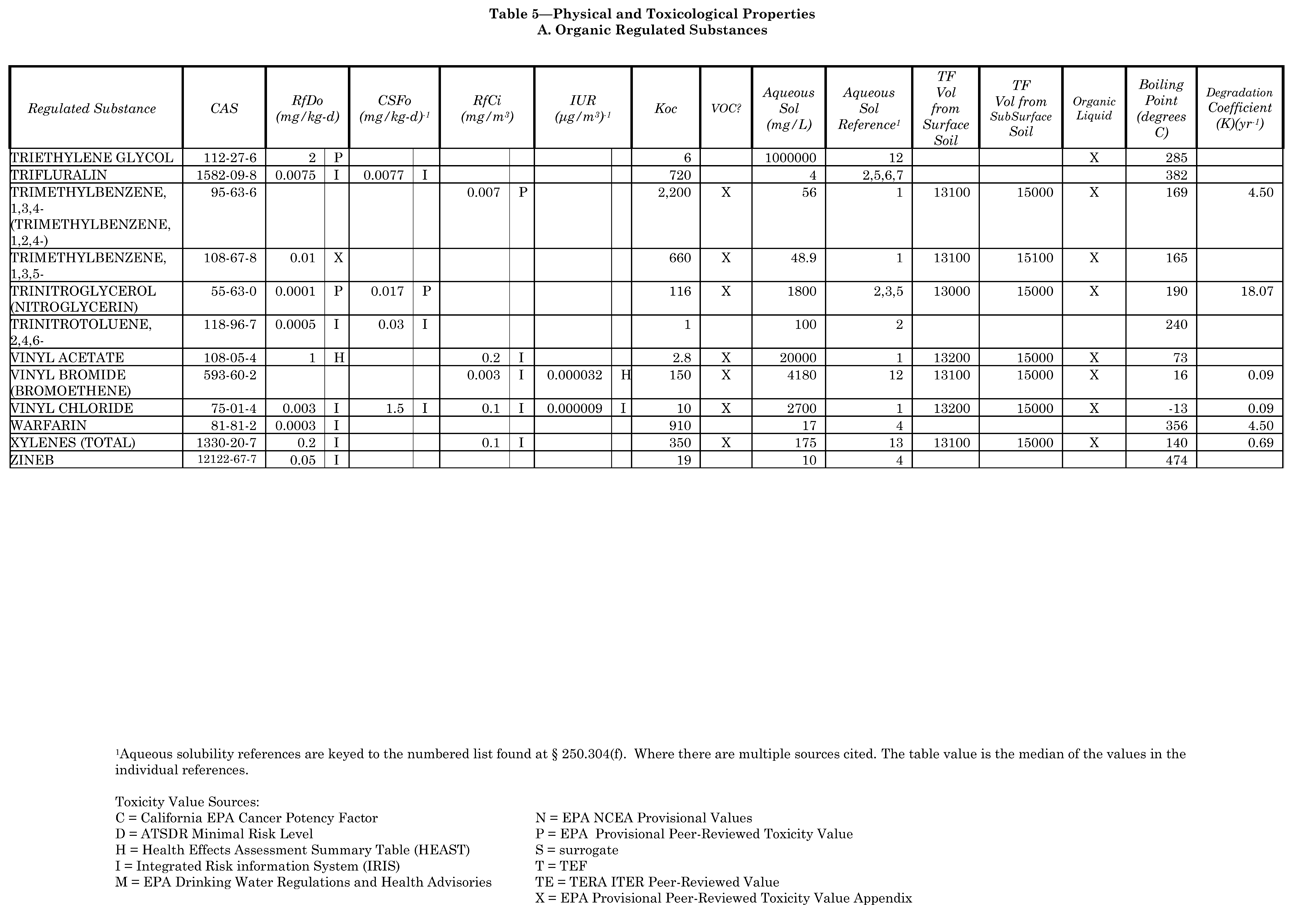
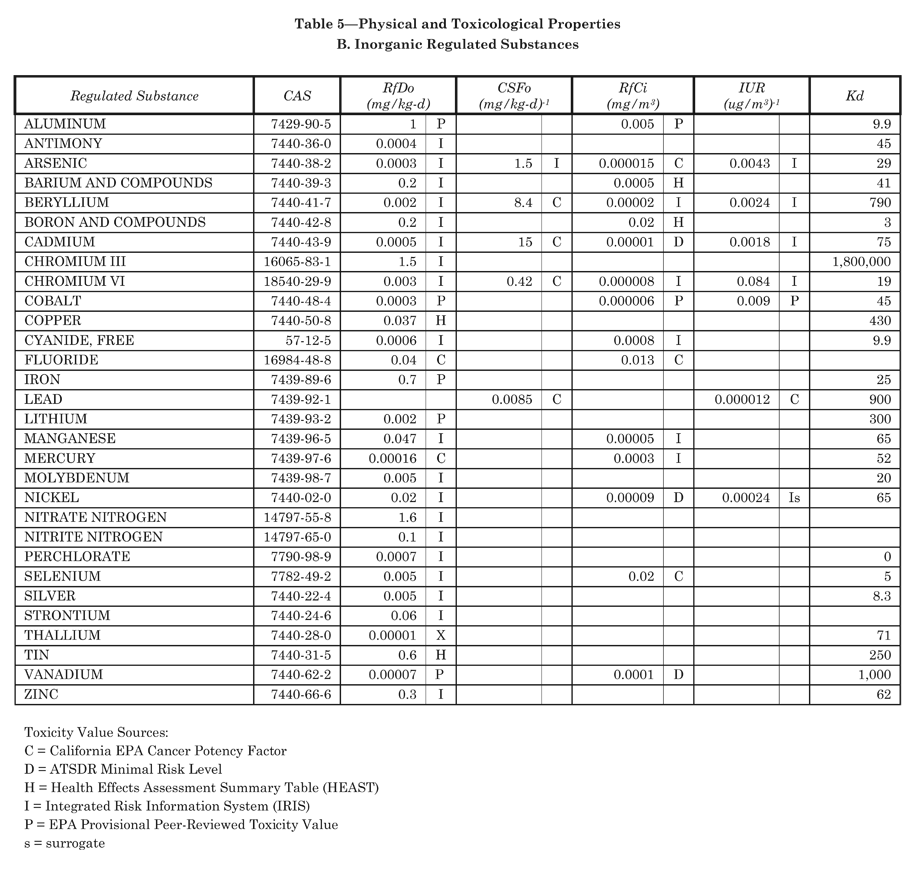
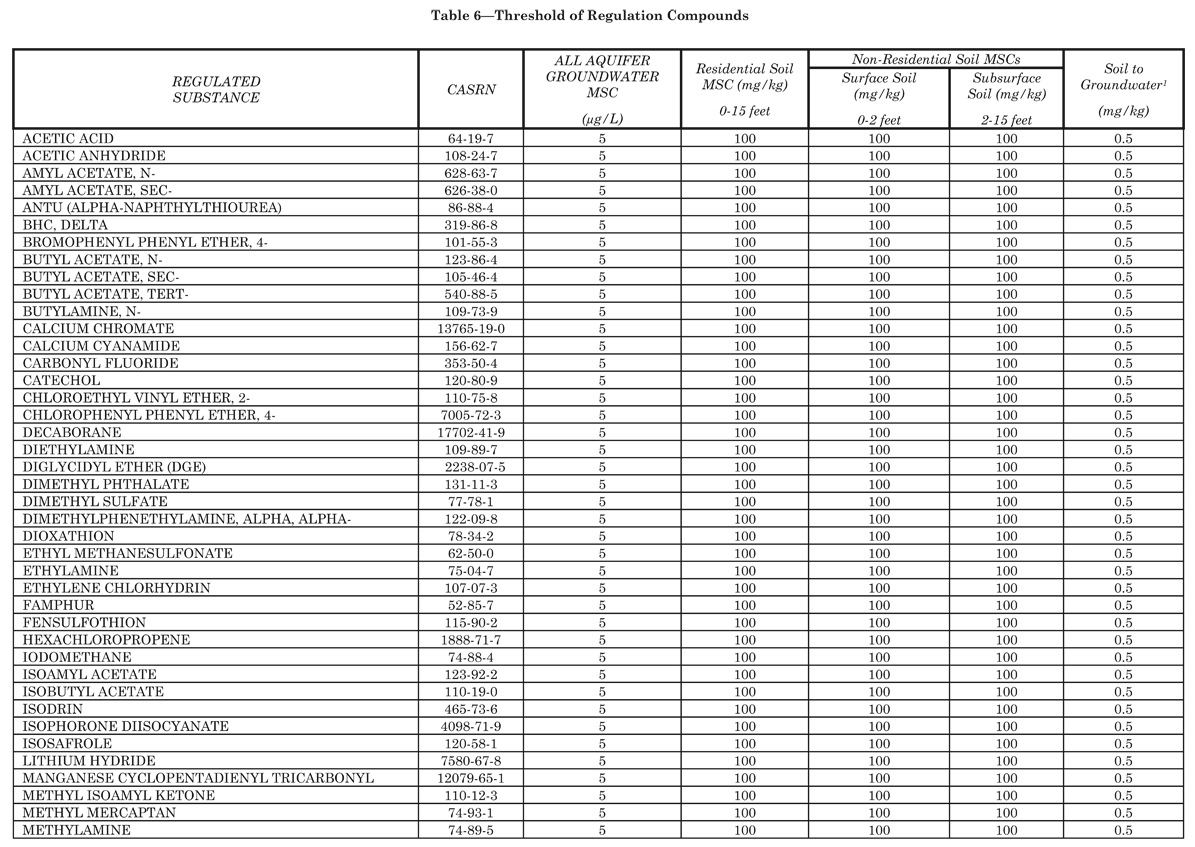
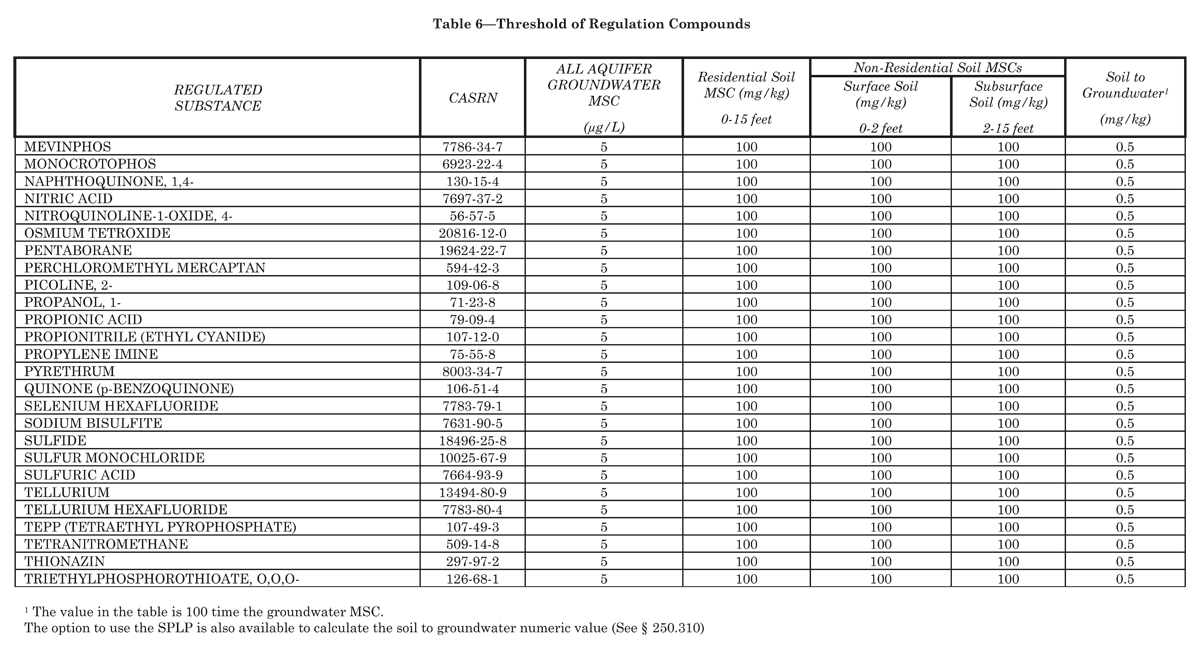
[Pa.B. Doc. No. 16-1508. Filed for public inspection August 26, 2016, 9:00 a.m.]
No part of the information on this site may be reproduced for profit or sold for profit.This material has been drawn directly from the official Pennsylvania Bulletin full text database. Due to the limitations of HTML or differences in display capabilities of different browsers, this version may differ slightly from the official printed version.